![[Headline]](../../../technik/sonstige/headtran.gif)
![[Headline]](../../../technik/sonstige/headtran.gif)
The SPIEL '10 Games Convention |
|
Hi again folks! It is thursday and I am back on the biggest game convention in my home town Essen. As always I still had to work the first part of the week and so I had to wait until the fair opens for the public today. Also nearly traditionally, I woke up on Monday with the beginning of a cold creeping up my throat and until now this has developed into a heavy cold. I am still hoping that I will escape the common cough, but I have a negative foreboding about that. So I am hoping that I will keep a stiff upper lip in the next four days, because in the preliminary reports of the fair I had seen some very interesting new games.
As we still have autumn holidays in our country the entrances and the halls of the fair were very crowded again. Maybe you will get some impressions from the pictures, but if not you can trust me, it was really really crowded at the beginning. 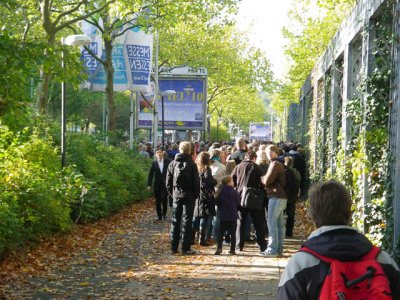 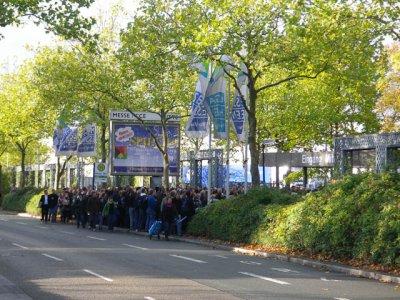 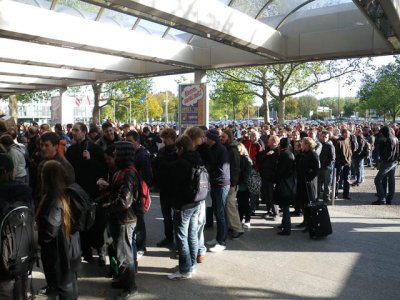 Despite of these crowds of people, I was lucky to find a free seat at a table at the SCHMIDT booth where I had the chance to do two tests early in the morning. The first one was Die verbotene Insel (forbidden island) from Matt Leacock. In this game the players try to rescue four unique artefacts from an island that is flooded step-by-step during the game. Only if the players are successful in this task they have a chance to win the game. But before they succeed they must leave the island from the helicopter landing field, of course with all artefacts in their hands. And, still worse, they must leave the island together. If only one of the characters, whose role the player fill in the game, is lost in the search, the game cannot be won any more. So as you will already assume, Die verbotene Insel is a cooperative game and can only won by all players. To my mind the game has an attractive design. Although it is only a card game, it felt more like a board game, because the 24 island cards are quite heavy and are spread out on the table at the beginning of the game. By this you can create the board to your wishes. For example, you can arrange the different island cards more like a bone or like an atoll. This shape of the island also influences the difficulty level of the game, because once parts of the island are separated by the flood, it is only possible to get there by special abilities or with one of the action cards helicopter. 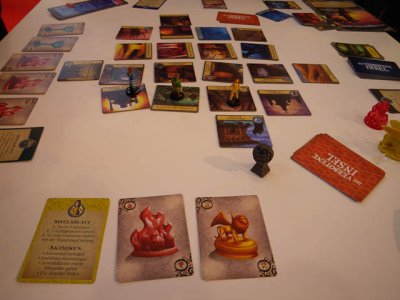 Now in the game the players move their characters along the island from one card to the other. Each of the six available characters has its own special abilities. So for example an engineer can drain two adjacent landscapes instead of one in a turn. The special abilities of the characters complement each other perfectly and the players can definitely improve their chances to win the game, if they are able to arrange with each other. A turn of the game is quite simple. First of all the players may move their characters according to the character´s movement rules to an adjacent island field. In the next phase they may drain a flooded island card by flipping the card to the other side again. But this is only possible as long as the flood has not completely engulfed the card. If the flood has hit the same card twice, this part of the island is lost permanently. After that the player may exchange cards of artefacts in their hands with their neighbours. Artefacts can be found in the next phase. But this is only possible, if the player has four artefacts cards of the same type and stands on an island card, where he can find the corresponding artefact. Two new artefact cards are drawn every turn by each player. Finally the flood strikes back and new parts of the island are flooded again. Characters have to be careful, because they can be carried away by the flood and then the game is lost for all players. A big annoyance are some special cards that rise the flood. If such a card is drawn all island cards that were flooded in the past turns are taken back on the stack of island cards, but unfortunately on top of this stack. So the chance that they will be flooded a second time is quite high and it is a good advice to drain these landscape parts soon again. My first testing round took us only about 10 minutes. Then an island card where we could find the last artefact of one kind was flooded finally and the game was lost. Still I got the impression that the game is very funny. The story of the game fits to the beautiful design and the clever special abilities of the characters. It is fast-paced and explained in about five minutes. Of course you don´t have to expect a high strategical or tactical game, but to win the game it needs a lot of talking to the other players and a clever input of the special abilities. Good cooperative games often are complex or stupid, but Die verbotene Insel seems to be a proof that light-weighted cooperative games can be fun, too. 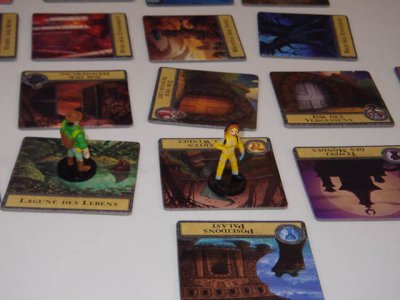 After that we took a copy of Loch Ness from HANS IM GLÜCK. This game is quite easy, too. Players take the role of reporters who try to take pictures of the the famous mythical creature. For this they bring their three cameras in position around the sea where the creature was seen. But before that each player takes one of his cards that show numbers from one to five and places it upside down on the table. When the last player has chosen his card, these cards all are turned over. The sum of the numbers of all players is the number of steps Nessie moves forward along the cost of the sea. The trick to win the game is to place his cameras exactly to the part of the coast where Nessie will move next. Of course this is not so easy as it seems to be. The reason is that you only know your own number and not the ones of your opponents. Two things help you by your guess. The first one is that you conclude from your opponent's choices for their camera positions what number they could have chosen. The other thing are special abilities each player can choose from every round. One of these enables the player to look under one other card on the table, before the cameras are placed. Other abilities allow the player to move Nessie one step further after the normal movement, and another one to place an additional camera. Now what do you get as a reward, if Nessie actually ends its movement right in front of your lens? Of course, you will get victory points, even if you are not exactly in front of it, but only on the same coast segment. But if you really meet Nessie from eye to eye, you have the chance to take a picture which gives some more victory points at the end of the game. In my opinion Loch Ness is a pure family game. For me, there were not enough possible actions I could chose from. The mechanism of guessing the right movement steps of Nessie is quite nice, but nothing totally new. Still the game seems to work very good. 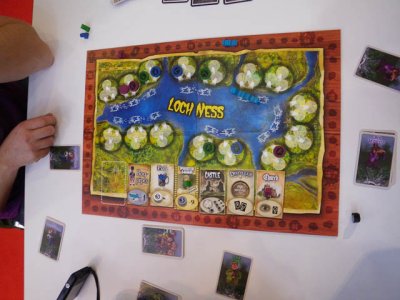 After that I had a walk through the halls of the smaller publishers and met Kulkmann. He advised me to have a walk over to the Cologne publisher ARGENTUM. Here you could find an expansion for Hansa Teutonica and a revised version of last year´s Last train to Wensleydale from Martin Wallace. This revised version is named First train to Nürnberg. In contrast to the original game, it is now playable with two players, too. For those of you who have not played Last train to Wensleydale, like myself, I had a short introduction at the booth: Players take on the role of railway bosses who try to establish a mighty railway system, buy trains and transport goods and passengers from one town to another. Depending on the number of players, an individual board is used. So this is the reason, why it now works with two players, too. Like the name assumes, the area around the German town Nuremberg is the setting of the game. Each round begins with a bedding round for influence markers and adjusting the influences on the two mighty railway companies, the machinery parks and the government due to the result of the bidding. Then there is a phase of expanding the railway system on the board. Every player builds his own system and pays for it with investment markers and influence. The prize depends on the length and the situations on the board. For example some areas are owned by stubborn land owner who must be "convinced" by the the government with influence. In the next phase the players can buy trains and transport goods and passenger. For the latter the players get victory points. The limit and the kind of good depends on the different trains a player may buy. My first impression of First train to Nürnberg is that it seems to be a very good railway game. It was explained and understood in only some minutes. Still there is a lot to plan and think about during the other player´s turn. The good news is, that you do not have to think about which game to buy. If you prefer playing the original game, this is no problem, because it is fully included in the new box. 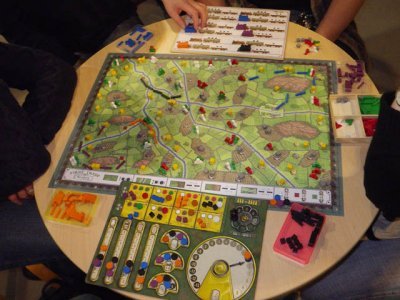 |
Well, Ralf was certainly right about the queues outside and inside the halls, and this year I could experience that the run on all these small convention giveaways was even greater than before. An example here was the DAYS OF WONDER booth where every purchase of the new Don't Panic! expansion for Smallworld was awarded with a free copy of the Necromancer Island Mini-Expansion. Nearly 20 minutes of queuing were necessary just to make the needed purchase!
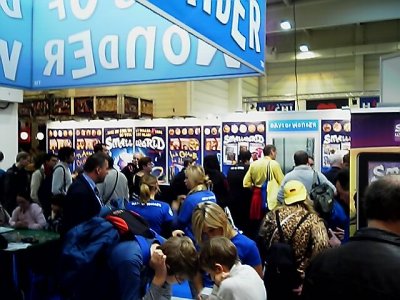
However, there are better things than actually queuing for a new mini-expansion, and as I had promised you yesterday I have used the pre-convention time to work out a little surprise package. So, with the kind permission of Michele Mura and RED GLOVE I now present you a new home-brewed mini-expansion for Michele's challenging crusades-game Jerusalem:
Many of you will have seen the Kingdom of Heaven blockbuster movie with Orlando Bloom, but some of you might be surprised to hear that characters like Balian of Ibelin really existed as historic personalities. So, you now have the possibility to assume the role of one of these personalities in Jerusalem, and so I present to you today the first of a set of four character sheets which you might want to print out and add to your game!
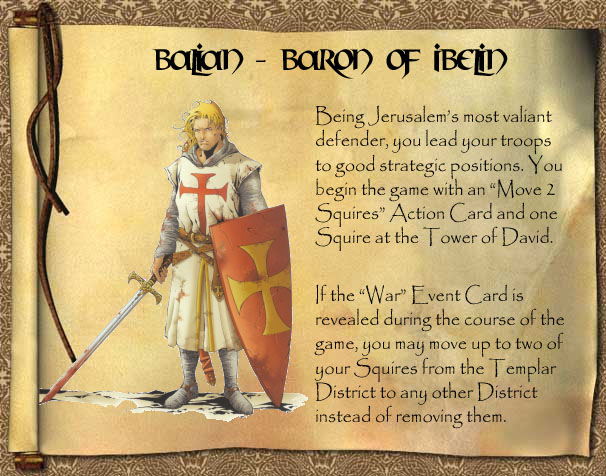
Please note that the character-artwork for this character comes from the thrilling French comic series CROISADE (=crusade) by Jean Dufaux and Philippe Xavier. All rights to these graphics are reserved to the authors. No challenges to their status are intended.
During the remaining afternoon I had made some purchases of games which I didn't want to miss, but I had to end this day at the SPIEL convention a bit earlier than usual because I had planned a gaming evening with a few friends. So, a bit later, I arrived at my house accompanied by my fellow IGA committee members Stuart Dagger, Andrea Ligabue and Mik Svellov, and Gordon and Fraser Lamont also had joined in for the evening because we were planning on testing the highly awaited 7 Wonders civilization cardgame.
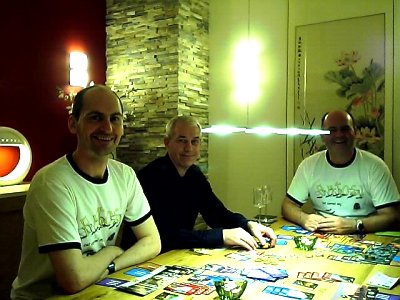
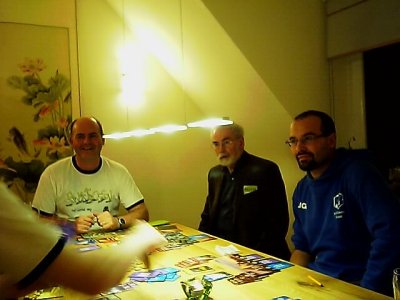
Review: 7 Wonders, Antoine Bauza, REPOS PRODUCTION, 3 to 7 players (2 player optional rules)
As the former IGA-winner Through the Ages has shown to us, the "boardgamization" of all these endless ages of human civilization has led us to hard challenges of resource management, building wonders and other modern comforts and, of course, investing lots of playing time. However, as it seems the Belgians with Sombreros (a.k.a. Cédrick and Thomas from REPOS) have become fed up with these never ending gaming evenings, and so they have decided to publish Antoine Bauza's newest game 7 Wonders which brings us three ages of civilization in a nutshell. I must confess that I was rather intrigued by the idea of a fast playing civilization game, and I was getting even more curious by the fact that 7 Wonders can be played with up to seven players! I couldn't imagine that any sustainable build-and-development concept could be played with so many people within a reasonable timeframe, and so I was looking forwards to the publishing of the game at the SPIEL 2010.
As indicated, 7 Wonders runs for a total duration of three ages (rounds), and each player starts with a randomly drawn plan for one of the Seven Wonders of the World, a start capital of three coins and a hand of seven building cards corresponding to the current age. The central playing mechanism for all three ages is a system forcing the players to chose one of their handcards for an action, and then pass on the rest of their hand to their neighbour (1st and 3rd age clockwise, 2nd age anti-clockwise). This playing and passing continues with each player once again choosing a card and passing the rest of their hand on until the players are down to just one card each. At this point an age will end, the remaining cards are discarded and the players each draw a brand new hand of seven cards from the deck of the upcoming age.
Well, this rotation of the players' hands certainly leads to a jolly revelry, but what can the players actually do with their chosen cards? Foremost and most important, a player can opt to build the building shown on the card, placing the card in front of him and paying the costs indicated on the card. Especially some of the cards from the first age can be played for free, and there also exist some cards which can be built just for a bit of money. However, all the advanced cards require more than money, since here the player must possess the resources required for the erection of this building.
Many of the buildings of the first age and some second age building have a capacity to produce resources, but instead of representing a player's resources by tokens it is sufficient to possess buildings with a total production which satisfies the building requirements of the new building. This rather simple mechanism goes without the use of resource markers and works because each player can only build one new building per turn (remember: the players are allowed to keep only one card before passing their hand on). However, this mechanism also results in a possible waste of overproduction if resources go unused: no resources may be kept for the following turn(s)!
Still, there are some options for a player who wants to build a specific building but is missing the needed resources. One possibility here is trade with the players sitting either to the left or right. If one of these two players possesses a building which produces the required kind of resources, the player who needs the resource is allowed to pay two coins to the building's owner and then use the production capabilities of this building for building his card. There is no possibility for the owner to refuse his trade, but on the other hand this temporary use does not hamper the building activities of the owner, since he can use the building's production capabilities to build his own card as well. Another possibility for a cheap building is by following the development rule. Thus, many of the buildings from ages one and two list one or more buildings from the following age in a special development column. If a player who has built such a building stumbles upon one of these developed buildings during a later age, he may build the developed building free of charge!
Players who cannot or do not want to build the building shown on their chosen card have two additional options what they could do with their card. On the one hand they may simply discard the card, gaining them an income of three coins for making this sacrifice. On the other hand a player may decide to build one stage of his Wonder. Once again the players need the matching kinds of resources to build their Wonders, but when a player possesses the needed resources he may declare that he builds the current stage of his Wonder and then places his building card face-down under the Wonder in order to represent that a stage of the wonder has been built. Here the stages of all Seven Wonders of the World trigger different effects for their owner, and so the building of a Wonder-stage may increase the player's income in terms of resources or money, bring additional victory points or even allow some kind of special action.
The special actions which become available through the Wonders and some of the buildings may be used by the players for a range of purposes. As an example, some of the buildings are good for trade, and they may allow a player to buy resources from his left or right neighbour at a reduced rate of one coin. Other buildings may bring a one-time income for each building of a specified category which can be found either in the player's own display or with one of his neighbours, and the Wonders offer even other actions like allowing the Wonder's owner to play an additional building or to take cards from the stack of discarded cards.
Talking about building categories, there are seven different types of buildings which can be found in the game. These categories can be distinguished through a card's coloured outer edge, since each category has its own colour. The buildings producing resources fall into two categories, and an additional category exists for the cards which are beneficial for trade. Another category exists for civil buildings which will bring victory points at the game's end, and yet another category is reserved for military buildings. These military buildings increase a player's military strength, and at the end of each age the players are bound to initiate military conflicts with their neighbours by comparing their military strength with those of their left and right neighbour. In this comparison the player with less strength is always assigned a defeat marker which will cost him one victory point at the game's end, whereas the winner of such a comparison receives an award of one, three or five victory points (depending on the current age).
Research buildings form yet another building category, and each research building will bring the player one of three different research symbols. At the game's end a player multiplies the amount of each research symbol with itself to see how many victory points he has gained from research, and since four buildings can be found for each research symbol a player with all four buildings of one kind can score sixteen victory points (4 times 4). However, consistent research also is awarded, and so an additional seven victory points can be scored with each set of research buildings showing all three different kinds of research symbols.
Finally, and rather important for the final evaluation, the seventh and last category of buildings is reserved for the guilds. Depending on the number of participating players, a certain amount of guild cards is secretly drawn and shuffled into the deck for the third age. The guilds can be built like any other building, but their purpose is to create victory points depending on the final setting of the game. Thus, some guilds give additional victory points for each building of a certain category which can be found with one of the two neighbouring players, whereas other guilds may bring additional points for completed Wonder stages, buildings in the player's own display or defeat markers found with the neighbouring players. As indicated, the guilds are found in the third and final age, and here a matching guild card may bring a nice victory points bonus for a lucky player.
Indeed, luck plays a higher element in 7 Wonders than in games like Through the Ages where players prefer to have their destiny fully under control and want to calculate each and every risk. Here the players have to live with the option of best choice for each game turn, and they cannot count on the fact that a specific building card really will be passed on to them. For this reason I first was a bit afraid of the guild cards and their victory points bonus, but since they become available rather late, stand in competition with other powerful buildings and strongly depend on the activities of the neighbouring players their impact is still moderate. Even a good guild bonus may be counterbalanced by victory points scored in other categories, and here the players can follow different ways to pursue their aims. They can invest in Wonders or research, they can try to further their aims through military buildings or simply go for expensive civil buildings. Trade also is an option, and so quite a few ways to victory can be chosen. This partly counterbalances the highhanded card distribution mechanism, but it cannot gild the fact that the players face a speculative, turn by turn optimization task.
However, these words might sound more harsh than intended, since 7 Wonders is not intended as a strategic heavyweight. Quite the opposite, the game works astonishingly well even with a manning of six players, and here the fleet-footed card rotation and building mechanism is needed to keep the entertainment value high. A clever move especially for a larger group of participants is the fact that the players can focus on the activities of their immediate neighbours, since the rules for trade, military conflicts and guilds do not apply to any player sitting further away. Thus, the players do not need to analyze the situation all around the table for every step they want to take, and this really speeds the game up.
Even more interesting, the specific setting allows a bit of speculation and nice conflicts of card choice. When a player receives a new hand of cards he will be looking for a card to add to his own display, but at the same time he needs to keep an eye on the display of the player to whom the cards will be handed next. Thus, there are times when a hand of cards contains a card perfectly matching the player's intention, but at the same time another card will be even more prefect for the neighbour to whom the cards should be handed. And here we go - should this card be passed on or held back (possibly for a meagre reward of 3 coins if it must be discarded unused).
Overall, these elements anchor 7 Wonders in the vicinity of the HANS IM GLÜCK classic Ohne Furcht und Adel, since both games offer building and development capacities at a high pace. The old classic just features a higher degree of direct player interaction, but otherwise 7 Wonders really is a worthy competitor which will bring fresh air to the well-trodden routes of build-and-development games.
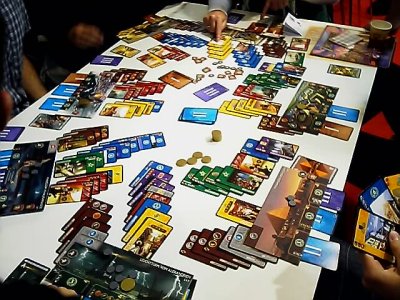
But I guess I better end here for today. It's nearly 2 AM over here in Germany, and tomorrow follows the next day of the show!!!
Welcome back again!
Once again a day at the SPIEL has passed, and once again I have spent the whole day at the show in order to see and playtest as many games as possible. After my good experiences with 51st State yesterday I had decided that I simply needed to check out some more good looking games coming from Poland, since I had seen nearly half a dozen interesting looking games during the previous days. But enough of the small talk, you are here to read something about games, and so here we go!
Review: K2, Adam Kaluza, REBEL.pl, 1 to 5 players
I made my way over to hall four were many of the small publishers are located, and at the booth of REBEL.pl I met Maciej Teleglow who actually is the product manager for the new game K2. Looking fearfully at the mountain of new games released at every SPIEL, you might be led to forget that there exists life outside the convention halls, and some of the outdoor mountains tend to be even higher than any pile of games. However, sometimes an author allows us a furtive look at the outside world, and so K2 takes us onto a mountaineering expedition which has set off to conquer the menacing K2 in the Karakoram Range. The well-done artwork and the look of the gaming components of Adam Kaluza's game invite players to try the long and arduous trip to the summit of the K2, but since the K2 is known for the difficult ascend and a high fatality rate it is rather comforting to sit down on a gaming table instead of preparing for a longer trip to Western China.

The game runs over a total duration of 18 days (rounds of play), and within this timeframe the players try to get as high as possible with their two mountaineer figures. The K2 is split into different altitude zones, and whenever one of the player's mountaineers reaches a new height the corresponding scoring marker of that mountaineer will be adjusted accordingly, thus representing the highest position that particular mountaineer has reached during the course of the game.
The gameboard shows the K2 in all its magnificence, and from a base camp at the lowest corner of the board several interwoven paths lead up the mountain. Each of these paths is divided into round spaces, and the players will try to move their mountaineers from one space to the next, always focusing on the most valuable space on the K2 summit. The movement of the mountaineers is based on a streamlined movement point mechanism, with each of the spaces showing how many movement points a player needs to pay if he wants to enter the space with one of his mountaineers. The movement allowance is generated from a fixed deck of 18 cards held by each player, and usually a player holds a hand of six randomly drawn cards from which he must chose three for the current turn. Only during the 6th, 12th and 18th turn (when each players' deck is exhausted) the players will have to use up their remaining hand of three cards before their decks are shuffled anew and a fresh new hand of six cards is distributed.
The players may not simply add up the movement point total and split this value between their two mountaineers, but they are allowed to assign each mountaineer a varying number of cards, possibly even using all three cards for the benefit of just one of their mountaineers. Three different types of cards can be found in each player's deck, and the most easy type are the movement cards which simply offer a movement allowance which can be used. The second type of cards are the rope cards, and these cards bear two movement values instead of one. One movement value shows the number of points a player may use for moving his mountaineer upwards, whereas the second value applies if the card is used for downwards movement.
Moving downwards? Why the heck should a player decide to go down the mountain, when the higher victory point values await the successful mountaineer on the K2 summit? Well, here we come to the most crucial part of the game, the acclimatization level of each mountaineer. Each player holds an overview board which shows the current acclimatization level of each of his mountaineers, and comparable to classic life points a mountaineer will be removed from play if his acclimatization level ever drops below the starting value of "1". The lower part of the mountain actually features spaces where a mountaineer who stops his movement on this space will gain an acclimatization point, but the upper part of the K2 actually contains spaces with a rising demand of acclimatization points. Thus, a player has to plan his trip into the upper regions carefully, since a mountaineer running out of acclimatization points will be removed from the game, counting a sobering, lonely victory point in the final calculation. Thus, a player's aim is not just to get his mountaineers into a high altitude, but he also needs to take care that both mountaineers survive until the game's end, and so it may be wise to turn around and descend again after a certain altitude was reached.
The acclimatization level of a mountaineer may also be rised through the third kind of cards available in each player's deck - the acclimatization cards. These cards can be used to keep a mountaineer fit and fresh, and especially players who have gotten more familiar with the game will discover the planning possibilities arising from the fact that each player is running on a fixed deck of 18 cards. Thus, players who are familiar with the card distribution within the player decks can try to plan ahead for the next few days, relying on the information which cards still can be found within the limited scope of their deck while at the same time not being absolutely certain in which round a desired card will appear.
Player competition is reached on the gameboard through a maximum number of mountaineers which may be present at any given space, and this maximum value is adjusted both on the number of participating players and the current altitude level. As a general rule, the spaces at a higher altitude may contain less mountaineers than the lower spaces, and despite the fact that a mountaineer may move through a space containing the maximum number of mountaineers the ascend becomes more tricky because the mountaineer may not stop at such a space. In addition, movement gets even more hazardous by the fact that all players will chose their cards for the current round simultaneously, so that everybody remains uncertain of the actions chosen by the other players until the cards are revealed. And as a further pitfall, the player who spends most movement points for the current round will have to take one of the three randomly drawn, revealed risk markers which lie next to the gameboard. These markers have values from zero to two, and during his movement phase the player will either have to substract the value of the risk marker from his movement allowance or spend an according sum of acclimatization points of his mountaineers.
A factor which should not be neglected is the weather, and here the weather forecast will be simulated to a set of six weather cards, with each of the weather cards showing the weather of three days. Two weather cards are revealed at the beginning of the game so that the players will know the weather for the next six days, and when the last day of a weather card has been played through the weather card is discarded and the next weather card is drawn, so that the players once again will know the weather of the following six days. In gaming terms the weather can slow the players down by increasing the movement requirements for every taken step, or it can be more exhausting so that the mountaineers might lose acclimatization points (or a combination of both). However, the barometer-like representation of a day's weather also shows an altimeter, and so the negative influences of the current weather possibly might only be experienced at a certain altitudinal range. And, of course, there are also good days of bright sunshine when the mountaineers will not have to face any negative weather influence.
A further tactical element for the players are the tents carried by each mountaineer. So, each of a player's mountaineers has the possibility to place a small bivouac on a space he has reached if he pays once again the same sum of movement points which was required to enter the space. The bivouac will remain in this space until the end of the game, and despite the fact that it was built by a specific mountaineer if may be used by both mountaineers of the same team. In game terms, the bivouac means protection for the mountaineer(s) in the same space, and so it will lessen a possible loss of acclimatization points or even give a mountaineer an additional point in a space with no negative conditions.
Adam Kaluza has chosen the theme of his new game carefully, going into the rather unexplored terrain of mountaineering instead of trodding other well-known paths. And indeed, K2 offers a rather good implementation of the theme, taking into account pivotal factors like weather and acclimatization with easy but well-integrated mechanisms. Really nice is the fact that the players not only go up on their own, but due to the decreasing number of mountaineers which may enter each space there exists a good degree of competition to reach good positions. It is especially valuable to reach the K2 summit because it brings a haul of three additional victory points if a mountaineer gets there, and furthermore the first player to reach the K2 summit will win the game in case of a tie. Thus, the race for the summit is on right from the start…
Finally, it should also be mentioned that the game rules and components offer ample opportunities to increase the difficulty level. So, the gameboard is two-sided, with one side showing an easier path and the other side with much harder climbing conditions. Likewise, there exist two sets of weather cards - one for the summer and one for the winter - and the winter set contains much more difficult conditions than the summer set. The game also may be played as a family variant with each player receiving a special Rescue-card which may be used once for keeping a mountaineer in play which otherwise would have been lost, and taken together all these elements should ensure a high challenge even for players who have gotten used to walking up the K2 once a week…
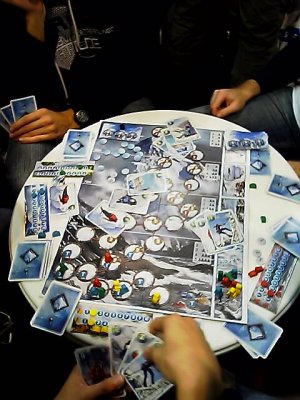
Well, this was really a quite nice appetizer for the day, and staying a bit longer in Hall 4 I examined some more products of Polish publishers which all could be found on nearby booths. One of the companies I visited was the team of KUZNIA GIER, and last year they had brought to the SPIEL the rather dark themed gangwar shootout game Kingpin. One of the small expansions announced for the SPIEL actually was a new gang for the game, and indeed the eight newly created tiles of the Colombian Cartel now were available. Actually, these tiles do not come with a new set of rules, but instead they use the same kind of symbols and abilities as the gangster organisations of the basic game. However, the individual characters once again differ from all the other organisations, and so the Cartel once again demands of the players to adapt their strategy to the abailities of their gangsters.
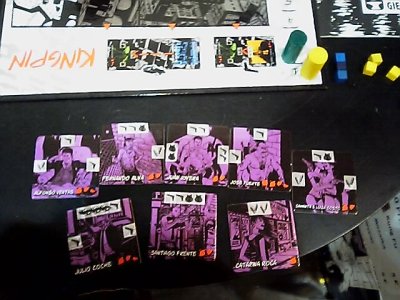
In another nearby booth the team from the Japanese publisher JAPONBRAND must have felt quite relieved because, after long delays which were caused mainly by a courier service, they finally got their games today! I remember that I had seen the team of JAPONBRAND finishing their booth on tuesday, and it must have been quite horrible for them to operate their booth for the whole thursday without any games to sell, and so today they finally could start unpacking the boxes and setting their games up. Having pre-ordered a copy of Grimoire, and interesting looking cardgame with a fantasy setting, I actually overheard some conversion between the JAPONBRAND team and a customer. Each of the games produced by JABONBRAND actually only was available in numbers between 50 and 100 copies, and as it seemed all of the games were pre-ordered by customers who knew this situation from previous years. This actually caused some frustration amongst people who had been waiting for the games to arrive, but all that could be offered was that the people could return on sunday in order to see whether any pre-ordered games had not been collected.
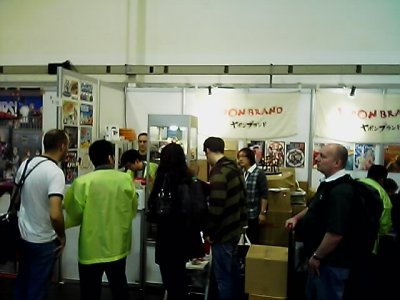
The JAPONBRAND game Grimoire comes like most of their other games in a rather small gamebox, and it is a game about a bunch of wizards which have set out on a quest to find companions and treasures. Definitely not a new topic, but during my preparations for the SPIEL I had found and announcement of the game, and the interesting looking artwork plus the comparatively low price of 14 Euro had been enough to make me pre-order the game. Now I was quite surprised to see how much plaing material had been squeezed into the tiny box, since it contained 80 cards, 28 printed chips, one playmat, four small sized spellbooks and even a "Pirate" promo-card plus a german rulebook had been included.
The game's title actually reveals quite a bit about the game, since each player gets his own little spellbook from which he will choose the actions for the current turn. At the beginning of the game only spells from the first six pages of the spellbook can be cast, but with every new turn a new page of the book also becomes accessible. After the display of treasures and companions for the current round had been prepared, each of the players chooses a spell which he wants to perform and he puts a book mark card into the grimoire to mark the page with the chosen spell. Then all players simultaneously reveal their spells and deal with the different effects of the spells. Quite a nice and easy playing concept!
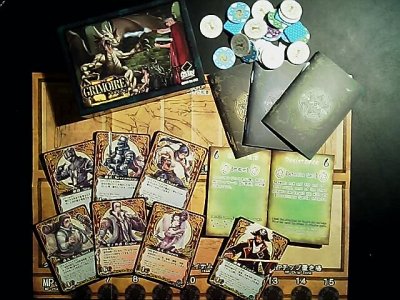
A few steps further down the hall I spied an interesting looking racing game at the booth of the French publisher CEPIA. They had tables on which big plastic racing tracks were set up, and on first sight the tracks with guard railings around the bends reminded me a bit of the old Carrabande / Pitch Car game by Jean du Poel. However, instead of snipping wooden disks along the track the game Bisikle requires the players to use a small plastic ball, and after the snipped ball has stopped the players place small bicycles in order to show how far they have come.
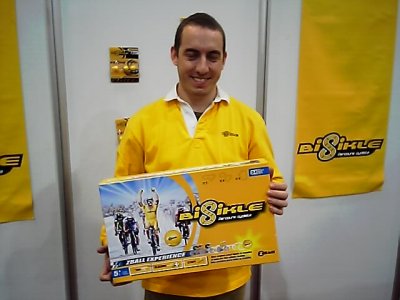
I was wondering whether a plastic ball really would be a better playing component than wooden disks, since a ball usually will keep rolling for quite a time and this would make movement in such a dexterity based game quite uncontrollable. However, one snip of the ball instantly showed that I was wrong with this presumption, since author Emmanuel Arnould actually had designed a very special ball just for this game. The plastic ball is hollow and partly filled with small metal balls, and in addition the inside of the ball's shell is spotted with dells. This gives the ball a high degree of precision when handled in the right way, and furthermore the ball simply stopps when it falls below certain speed because the small metal balls then will remain in the dells and keep the ball in place.
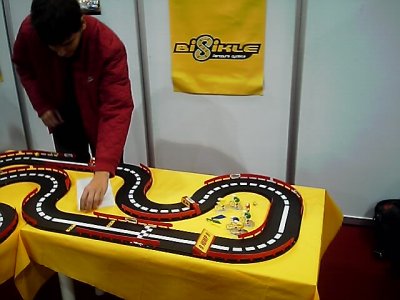
This invention really is ingenious, and I think it is perfectly suited for these kinds of games. Bisikle can be played with several players, and CEPIA also offers expansion parts which can be used to add more bikes or to enlarge the track. In terms of rules the game does not need much - all the players have to do is to agree on a certain number of laps. However, there is some room for additional rules, since the game also includes small flags which can be used to mark certain points among the track so that a race for points can be made. In addition, CEPIA also just released a a car version called RoadZters, and this one comes with small cars which make it more difficult to stage overtaking manoeuvres due to the size of the cars. However, a daring player actually can snip his ball into the car which drives just ahead of his own car, and since the cars trunks are formed like small ramps there is a possibility to simply jump over the other car.
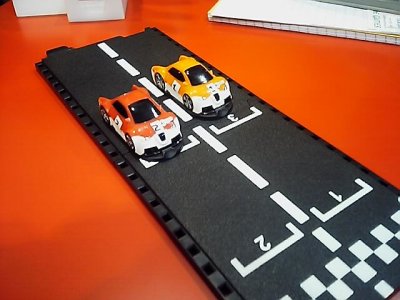
Staying even longer in Hall 4, I also visited the booth of the Finnish publisher TUONELA who had announced that they would be bringing a game based on the old computer classic Elite to Essen. At the booth I met the author of Phantom League Timo Multamäki and he gave me an introduction into his space opera game. So each of the players starts with his own unique spaceship and captain, and it is the aim of the players to become the most famous captain in the universe. However, such a carreer is not necessarily based on peaceful interaction, and so the game either can be won by positive fame or by negative fame which was accumulated through negative actions.
Apart of the starting system the game starts with a hidden map of the universe, and each of the sub-systems actually is made up from two half hex spaces. The revealed side of these hexes shows different planets which can be visited for trading purposes, and due to the fact that each system is made up of two half hexes the universe will be quite different from game to game. The discovering (revealing) of new systems actually is a way to increase a player's fame level through peaceful exploration, but trade also can be chosen because a good part of a player's fame can be increase through wealth. Another possibility to gain fame is through the completion of missions, and finally (negative) fame also can be gained by attacking other spaceships.
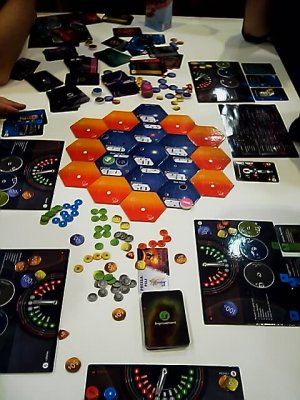
Combat between two spaceships is resolved without using a dice, but instead each player possesses his own set of battle cards. The composition of this set depends on the type of spaceship, the skills of the captain and any additional equipment, and the players have to decide which of these cards they whish to use in a combat round. It may be possible that the combat continues after the first round, but all cards only can be used once so a player will have to balance his choice of cards so that he might possibly get through more than one round of combat. However, it is also possible to try to solve everything with a single, crucial attack, but here the risk is high that a player has used up his most useful armaments if the combat continues.
Missions, equipment and many more elements of classic Elite have been squeezed into a rather small sized gamebox. As Timo told me, the gamebox actually has been downsized by the box-producer so that the deck of cards will not fit into the box, but this fault only will apply to the boxes sold here at the SPIEL, since all following versions of the game of course will be sold with a fitting box. Apart from this mishap, all components are functional and flawless, and the game even includes a control console with movable gauges for each of the players. A well done revival of a long forgotten classic!
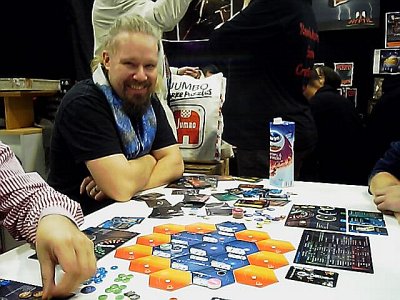
This actually finished my stay in Hall4 for today, but before I continue my own report with my attendance of the awards ceremony for the International Gamers Awards 2010 let's first have a look at today's activities of my co-author Ralf!
|
This morning I began the day more relaxed and I think I am beginning to get well again. And this is good, because there are still three more days of testing ahead of me. Today my sister went with me and I only did a few tests. And here they are! Today it was PEGASUS day for me: The two booths of PEGASUS were very crowded like every year. I was lucky to find a seat on a table, where three other guys just were beginning a round of Thunderstone. They did not mind taking me up as a fourth player and soon we found us confronted with monsters and a lot of cards. Like Dominion Thunderstone is a game about building a powerful deck of cards. Each player starts with 12 cards. These cards are shuffled and each player take the first six of these cards into their hands. Most of the cards have a value for attacking one of the three open monsters in the dungeon that are laid on top of the table. 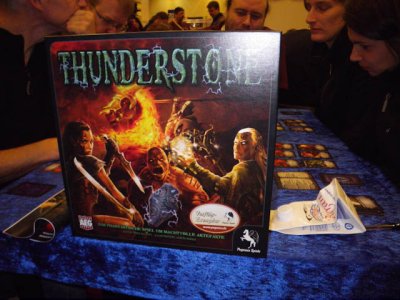 For an attack a player can use heroes, special items and spells. Heroes can use weapons, too, if they are strong enough. Each hero can only carry a specific weight and if a weapon is to heavy it can not be used by this hero. A supply card can help, making the hero temporarily stronger. Of course you can find all this additional equipment and the heroes in the cards on the table. At the beginning the player's deck is weak. To developing a deck a player can use his hand cards alternatively as money for buying new cards. Like in Dominion all cards have a specific value and there are many open card piles in the middle of the table. There still has to be said something about the dungeon. The deeper a player goes into it (indicated by the position of the monsters), the more light is needed to defeat the monsters. For this the player can use torch cards, otherwise defeating will be much more difficult. Finally you should know that heroes can be raised into a higher level with the help of experience points. These experience points are given to player's who have defeated a monster. You see, there are a lot of similarities to Dominion. The game mechanism is more or less the same. The defeating of the monsters and the ability to develop the heroes are something new. On the other hand, Thunderstone is much more limited in the combination of several cards. In my opinion Dominion at the moment is still the stronger game. But let us wait for the expansions for Thunderstone, then we will see. What can be said today is that Thunderstone will definitely appeal players with an aptness for fantasy themes. 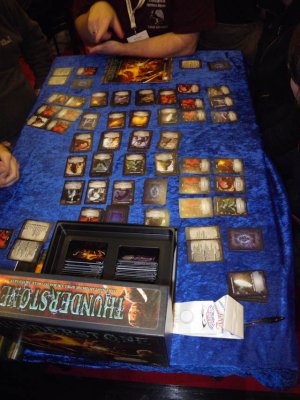 After that I only changed my seat to the next table, where Junta - Viva el Presidente was played. About 20 years ago the original game of Junta helped us overcoming many of our free lessons in school. We hurried up to the flat of Kulkmann's parents, who lived only about five minutes from school, set up the game and began betraying each other, starting revolutions and sending the other players into exile. We really loved this game. So it was a joy for me to hear PEGASUS has published a light version of the game that promises to retain the basic theme and shorten the time of forging alliances and fighting the revolts against the President. My thoughts about the new game were right. Junta Viva el Presidente definitely is a light version of the original game. But you can find a lot of the old mechanisms in the new game, too. But let us have a closer look to the game! Like the original game the setting is some unnamed banana republic that gets a lot of development aid from foreign countries. It is well-known that most of this money does not arrive to those who really need it, but vanishes on the way from the government to the ordinary people. Usually the president of the republic plays a major role in this game. And here we as the players come into play. We represent the corrupt government and one of us plays the president, at least for a while. This president, who wears real sunglasses as long he administers this office, draws cards of development aids at the beginning of each turn. He then promises a budget by giving every other player at least one card of this aid. All cards he does not give to other players, he may take as his personal supply. Then each player decides which player he wants to attack. It is possible to attack the president, if you are not satisfied with the budget, you can also defend him or you can attack another player. All this is indicated by dices that represent militias. At the beginning we start with only one militia, but it is possible to buy more, up to four militias. In the next phase, the result of all the attacks is determined. The attacker and the defender take all their militia dices that were chosen for this attack (or defend) and roll the dices. The bigger sum of the dices wins the attack. An exception is the defence of the president. In this the militias of the president count only as a one, but militias of other players who defence the president are rolled for the president, too. But why should someone defend the president? Well, this is quite easy. Only if the president survives, the budget of this round is approved and only then the players may take the promised cards into their hands. Otherwise all promised cards of the players go to the discard pile. The best tactic for the president is to give the strongest player very good cards from the development aid, so that he has no interest that the president is brought down and the budget goes to the discard pile. Probably he will defeat the president in this case. From all the money the players can buy new militia, but more important they can also buy buildings that give a victory point each. Five points are enough to win the game and this can go quite fast, if your opponents do not pay enough attention. All in all the game can easily played in about half an hour. The dirty and annoyance factor may not be as strong as in the original game and pledging an alliance is only important for the actual round, but the feeling in the game is almost the same. As a president you must bluff a lot, to let your opponents think that your current aid is the worst you have ever had and then you must rescue most of the good cards for yourself without being besieged. Although for me the real Junta remains one of my favourite games, the new Junta Viva el Presidente promises a lot of fun, too. 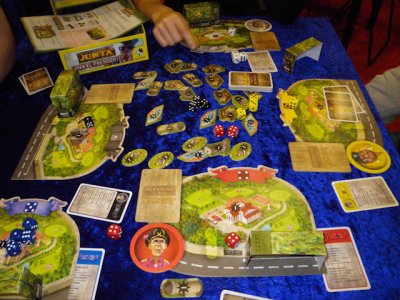 After my visit at PEGASUS I only tried one other game this day. Kulkmann already has written a lot about the pocket version of Mr. Jack. But because I loved the original game, I had to try it too. I even think it is stronger than the original game, because I am of the same opinion that the pocket version compresses the original game to the core mechanism. Only the prize of fifteen euros for such a small game may be a point of criticism. But convinced as I was, I bought it in the end. And then, of course, there was the ceremony of the International Gamers Awards this day which I attended together with Frank. It was me who took the pictures there, because Frank was unable to do this himself, since he was standing with the other members of the jury. That was it for me today. I think tomorrow there will be more to tell, because then I will be on my own once again and I will have more time for playtesting! |
That's right - without Ralf I would not be able to present any pictures from the awards ceremony, but now I have everything I need to illustrate my description of the event.
Once again the awards ceremony was scheduled to be held in the Saal "Essen", away from the crowds in the convention halls in a more quiet surrounding. The problem with this place is that not many spectators find their way up to watch the ceremony, but on the other hand the ever-present level of noise in the convention halls made it nearly impossible to understand the speakers in previous years.
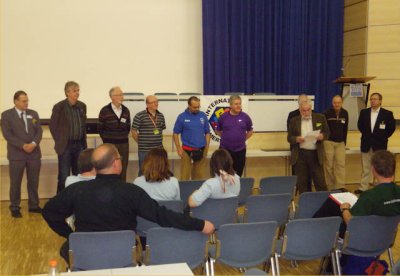
All IGA committee members attending the SPIEL usually will join in for the awards ceremony, and so quite a few members of our group arrived at 2 PM to celebrate this year's winners. On the photo above, you see from left to right Ferdinand de Cassan, Knut Wolf, Han Heidema, Ronal Hoekstra, Andrea "Liga" Ligabue, Alan How, Stuart Dagger, Mik Svellov (actually, you do not see him, since he is hiding behind Stuart…), me and Andreas Keirat. Our chairman Greg Schloesser had been unable to make the trip from the US to Essen this year, and so Stuart was giving the honorary speeches to announce the winners.
In the two-player category the winner of the IGA 2010 is the game Campaign Manager 2008 by Christian Leonhard and Jason Matthews. The game focuses on a strategic interpretation of the Bush - Obama campaign back in 2008, and the prize was received by Zev Shlasinger who had published the game at Z-MAN GAMES.
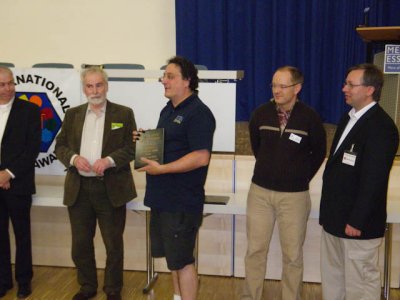
Christian Leonhard and Jason Matthews already had won the IGA in 2007 with their game 1960: The Making of the President, and this year now only the 2-player award was given to former award winners, but also the multiplayer awards went to an author who had already received it back in 2003. So, Martin Wallce once again was presented the winner's badge, and this year it was for his strategic masterpiece Age of Industry. Being based in the UK, Martin's own publishing house TREEFROG actually does not take the US production and distribution, and so a winner's badge also was presented to MAYFAIR GAMES who have taken the production of the game on the other side of the Atlantic.
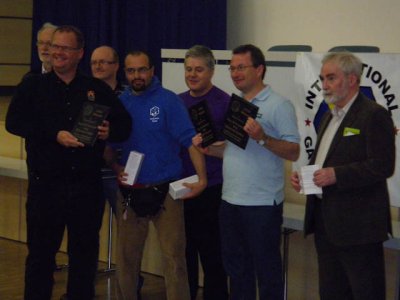
Talking of awards and prizes, let's not forget that there is a possibility for you to win something here, and so let me announce the
As I had told you yesterday, I was able to acquire a few copies of the Stronghold Heroes mini expansion, but today I was able to get quite a few more interesting items which are available only for visitors of the SPIEL. Thus, I could lay my hands on the Grand Cru and Asara Expansions which are shared out by the Austrian Games Museum, the "Warehouse"-Expansion for Funkenschlag / Power Grid, the "Jean-Claud van Rice" promo-card for Ghost Stories, the "Manneken Pis" wonder for 7 Wonders and the set of five Rattus bonus characters!!!
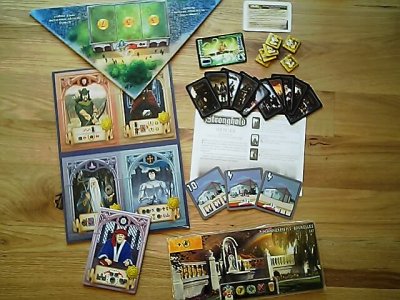
As indicated, you will need to sign my SPIEL Guestbook if you want to participate in the prize-draw, but to share these prizes out as fairly as possible every winner will be allowed to chose something from the available goodies. This will slow down the announcement of the winners and their notification after the end of the fair, but it should give you the chance to get an expansion which you might really want to have.
Well, there still was quite a bit of the day left after the awards ceremony had ended, and so why not have a look at another game or two?
Another game which I had seen at the new games show was Rallyman which was published by author Jean-Christophe Bouvier from France. It is a game about the Rally-sport, and you might possibly ask yourself now whether the boardgames world really needs another racing game. My answer to this question is a full and unconditional "YES!", because Rallyman really stands apart from many other racing game by its true and authentic adaption of the Rally-sport.
Review: Rallyman, Jean-Christophe Bouvier, www.rallyman.fr, 1 to 4 players
So, instead of moving some cars around a circular track in order to see who is first to cross the finish line, Rallyman actually focuses on the real design of a rally where the participants have to solve different stages among changing roads. For this reason the game includes several different double-sided gameboards showing different road-parts, and these parts will need to be aligned so that the first stage of the rally can be played through. Later, after the first stage has ended, the parts will be realigned twice for the second and third stage, and so the players will have to face new challenges with every new stage.
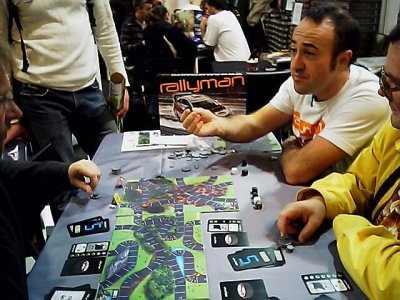
Movement of the cars along the roads is solved by the use of dice (gasp!) However, these dice will not be applied as randomizers in the usual sense, but instead each player possesses his own, identical set of five 6-sided gear dice (gears "1" to "5") and two 6-sided acceleration dice which will be used in a quite unique way. So, during a player's turn each dice can be used for moving a car just one space, but a player is allowed to use several of his dice in a row so that his car can move for several spaces. Important here is the fact that the different gear dices must be used in a correct order, so that each additional step either must be taken in the next higher or lower gear. The only possibility to move forwards without changing gear are the acceleration dice, but each player only possesses two of these and in addition it is quite necessary to use lower gears in curves since the car would be thrown off the track if the gear is too high.
It is essential to know about the Rally-sport that the winner of a Rally is determined by the measuring of driving time, and so the winner of Rallyman will be the player who has solved all three stages of the rally in the fastest time. Thus, the game required the development of a mechanism for the passing of time during the rally, and here Jean-Christophe had a rather good idea. At the end of each turn a player needs to collect a gear-card corresponding to the last gear dice used for movement during this turn, and each of these gear cards actually shows how many seconds had been consumed by this turn's movement. The higher the final gear, the less is the time consumption, and so the players will try to end their turns in a high gear to get fast driving times. However, here the curves in the road form a major obstacle, since each curve lists a maximum gear number which may not be exceeded for moving a car through the curve. Thus, the cards will need to slow down before entering a curve, and here the gear dice must be used rather wisely since each gear only exists once so that a car will not be able to slow down and speed up again during the scope of the same turn.
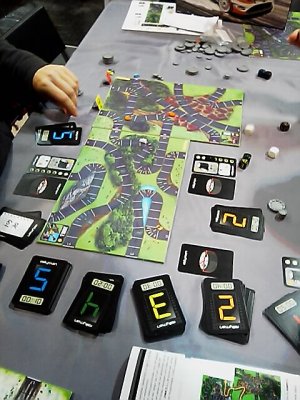
However, so far the game would need no dice at all, since the gears also could have been symbolized by markers. However, each dice must be rolled when it's used, and there is a possibility that the result of the diceroll is a warning sign. Rolling one or two of these signs within the same turn is okay, but when the second warning sign was rolled the player actually will need to consider ending his turn without using any more dice. Of course, the player may continue movement until he has used up all his dice, but if a third warning sign would be rolled the car would spin out of control and valuable time would be lost.
On the other hand, a player also may try to get bonus seconds by making a move called "time attack", and for this the player actually has to roll several dice all at once. If no three warning signs are rolled the player may move his car normally, and in addition the player will receive a "one second" bonus token for each dice used in this cumulative roll. On the other hand, there is a risk that three warning signs may appear, and this risk is not under control of the player since, in comparison to normal movement, all dice are thrown at once.
Around this core mechanism for movement quite a few additional rules have been added for finetuning, and here rally-fans will discover many elements which make their sport so enjoyable:
These are just a few examples of the detailed but easy to handle rally rules, and the game actually includes some additional elements which increase difficulty and competition between the players. For one, the track gameboards actually chose a winter side, and especially a stage containing both normal and snowy roads puts the players to a choice of tires because they need to take the weather into consideration. Another element are the checkpoints where the players must register their intermediate times. Here the times of all players will be recorded, and especially later players have a possibility to adjust their driving style depending on the performance of the players who passed the checkpoint before them. This rule keeps it quite easy to get intermediate results, and so the players always will know about the performance of their competitors.
As a quite astonishing fact, Jean-Christophe Bouvier has never designed a game in his whole life, but since he is a big fan of the Rally-sport he wanted to create a game which catches much of the atmosphere but remains funny and easy going in order to keep the players entertained. So, he took several years for the development of RALLYMAN, finetuning the rules to a very high degree. Having met quite a few first time authors at the SPIEL '10, it is astonishing to see that such really good ideas sometimes come from people who not even are passionate gamers. But even without detailed knowledge about games, Jean-Christophe has created one of the most challenging racing games I have seen, and especially the rules for the measuring of the rally time by gathering gear cards marvellously fulfil the intended purpose of creating a game which matches the rally-feeling. Despite the fact that the players mostly concentrate on their individual driving, there is much interest in the performance of other players since especially the follow-up drivers have a possibility to learn from any errors made by the leading car. So, with both the game mechanics and the atmosphere adding up to a quite harmonious whole, I can wholeheartedly recommend this game to anyone who wants to try out a quite unusual racing game.
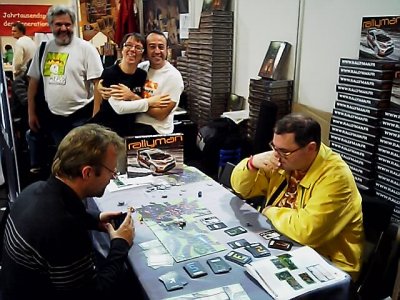
Well, there was still a bit of time left for a final playtesting session today, and as I had announced earlier I wanted to playtest a game from yet another Polish publisher. Two or three years ago I already spent a whole day of my SPIEL reports on publishers coming from Eastern Europe, and as this year's convention shows the trend for even authors and publishers coming from these countries still is valid. Thus, I would like to introduce now the new game Magnum Sal from GRY LEONARDO in which the authors Marcin Krupiski and Filip Milunski have focused on the establishing of Polish salt mines in the year 1368 A.D..
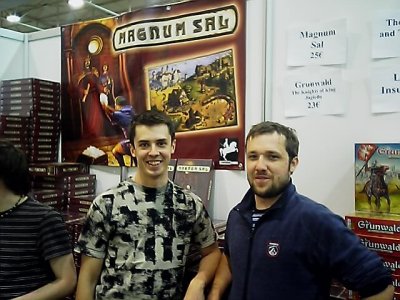
Review: Magnum Sal, Marcin Krupiski and Filip Milunski, GRY LEONARDO, 2 to 4 players
Okay, let's first face the basics: what we have here is a worker-placement game, coming with the needed meeples (representing miners or workers), a nicely drawn gameboard, wooden cubes of four colours to represent three different qualities of salt and subterranean water, markers, tool cards and order tokens. However, The locations shown on the gameboard show only a part of the possibilities where the players will be able to place their meeples, and so the lower part of the gameboard is continued by a mineshaft, going down for three levels in which face-down mine chamber tiles will be placed during setup.
It is the aim of the players to take the role of foremen who are competing to become the Royal Steward of a new salt mine. To reach this privilege, the players have to prove themselves most efficient in extracting salt from the mineshaft found in this game, and after a duration of three weeks (rounds) the richest player will have won the game. Salt cubes coming from the mine can be sold for varying prices at the market on the gameboard, but to gain as much income as possible the players need to keep an eye on the King's salt orders which are going to be revealed at the Castle on the gameboard. The King will richly reward the player who first brings him enough salt cubes of matching quality to meet one of his orders, and whenever five orders have been served by the players a week (round of play) is over and the following week will start.
At the beginning of each week the players take back all their meeples from the gameboard and the mine, and everybody once again readies any tools which have possibly been used in the previous week. Taking turns, the players then are allowed to perform two actions each, beginning with the starting player and going clockwise around the table until the turn in which the King's fifth order for the current week has been served. As it is custom in worker-placement games, the players perform their actions by the placement of workers (sorry, silly pun…). Most important here is the action in the mineshaft, since this is the place where the players will gather the needed salt.
Placing one meeple per action, the players first will go down the shaft itself, and then turn left and right into the unrevealed rows of mine chambers. However, meeples cannot be placed freely in the mine, but instead they can only be placed into new spaces if an unbroken chain of meeples goes back from the newly occupied space right to the surface. However, these meeples do not necessarily belong to the active player, but instead the meeples of all players are considered valid when it comes to uphold the unbroken-chain-rule. In this fashion the players slowly will use their meeples to populate the mine, and whenever a new chamber is reached it is turned over and the meeple is placed on the chamber's revealed side, together with the salt and water cubes indicated on the chamber tile.
This brings us to the question of how the salt can be mined. Here the rule must be followed that a player may use one action to mine as much salt from one chamber as he has own meeples present in that chamber, but he has to substract the amount of water cubes in that chamber from his total sum (ground water makes mining more difficult, especially on lower levels). However, it is not just sufficient to have miners in the chamber, but it must also be guaranteed that the mined salt is directly removed from the mine. Due to the unbroken-chain-rule there is a standing connection from any chamber with meeples right to the surface, but if the player performing the mining action needs the help of other players' meeples to transport the salt back to the surface (because he does not have a self-owned meeple in every space on the way from the chamber to the surface), the owners of meeples used for transportation will receive a fee of one coin for every salt cube the active player moves through such a space. This transportation mechanism is a bit similar to the transportation of the stone Moai in Giants, but only salt cubes for which the active player can pay all transportation costs can be removed from the chamber and placed at the player's stockpile.
The meeples who have worked in the chamber will get exhausted from mining salt and they will be turned to their side. A player will need to spend his whole turn to refresh all his tired miners in the mine, and then these miners either can mine salt again (if there should be cubes left in their chamber), or they can be moved within the mine at a rate of one meeple per action, provided that the unbroken-chain-rule is observed.
The outside world shows the Royal Castle where the King's orders wait to be fulfilled. A player ma place his meeple(s) in the waiting spaces outside the castle, and on every successive turn the figure(s) will move one step forwards, reaching the castle two turns after the player has made the initial placement. In the turn in which a meeple reaches the castle, the player either will have to deliver salt cubes matching one of the King's orders, or he will have to pay a fine if he is unable to fulfil any of the available orders. This actually may happen because the delayed arrival of the meeples leads to a waiting time of two turns in which earlier placed meeples may arrive at the castle and perform one of the desired orders. An interesting way to hamper an opposing player, since all personal stockpiles must be kept visible for everybody.
However, the player's even have the chance to acquire a salt cube needed for an order at the Salt Market. This market operates on a fairly straight system of availability and demand, but nonetheless it may be sensible to send a meeple there in order to buy a high priced salt cube which then may be used to fulfil an even better-paid order. In most times this will seem more sensible than taking the penalty for wasting the King's time.
Other locations available on the gameboard are the Inn and the Workshop. At the Inn additional meeples can be hired, and they will join a player's team for the rest of the game. The Workshop on the other hand offers privileges which will help at the Salt Market or the Castle, or tools which come in quite handy when working in the mine: a pickaxe strengthens a team during a mining action, a bucket can be used to move water cubes from one chamber to the next ("oops, I didn't know that someone was planning to mine in there…"), food helps to recover some meeples without spending a player's whole turn etc… All tools and privileges can be used once per round of play, and so they have a maximum of three usages if they are bought during the first week. This number of usages seems a bit unprofitable in consideration of the tool's prices, but game balancing seems to demand a restrictive use of the tools. However, especially on the lower levels with lots of water tools may offer the decisive edge, since they are cheaper than meeples and the pure white salt cubes which may be found down there are worth a fortune!
Water also can be removed from the mine using the Pump House. A player who sends a meeple there may remove a water cube from a chamber containing his meeples for free, and if money is paid even more water can be removed during the same action.
Apart from selling salt to the King and the Salt Market, players also gain a coin for sending a meeple to the Town Square (that's where the miners go for a game of dice), and they may also generate an income by sending a meeple to the Workshop, the Pump House, the Salt Market or the Castle to become an assistant. The assistant's owner will receive one coin from the bank whenever any of the players uses this particular location, and this will happen as long as the meeple remains in the assistant's position. To be honest, this last part with the location assistants first seemed to be a bit out of place in a game which concentrates on salt mining, but as playtesting showed the assistants are a sensible inclusion because they add another element of speculation. Thus, it may really pay up to remove a meeple from the mine to put him into an assistant's position when a few players (possibly including the assitant's owner!) are deemed to make a visit to that particular location.
As it seems Magnum Sal has been created and edited rather affectionately. All rules seem to be weighted well and thoroughly tested, and so the different elements of the game fall together to create a quite nice final result. While it is true that the one or other gamer may ask himself whether he really should buy another worker-placement-game, Magnum Sal offers some really nice ideas which make the purchase worthwhile. The game has enough unique rules which make it stand apart from the other products crowding this market segment, and what I like most is the rather nice implementation of the whole mining business: new chambers are discovered step by step, teams are sent in, tools can be used to enhance working efficiency, and even ground water needs to be taken into consideration. All in all a really nice simulation of the whole process, and much closer to the real thing than the "place a meeple - get a stone / wood / grain / sheep / brick / gold / victory point…"-mechanism found in many other games.
To my great delight Magnum Sal also offers wooden playing pieces and a graphic design which can keep up with any product coming from a major publisher, and so the game does not need to fear a comparison with high-standing award-winning titles like The Pillars of Earth. It is a strong and worthy contestant on all grounds!
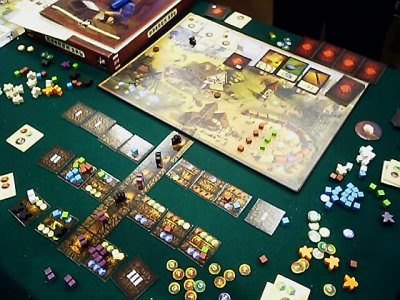
This brings my to the end of today's rather long report, but off course some of you might be waiting for the next Jerusalem - The Kingdom of Heaven character. So here she comes!
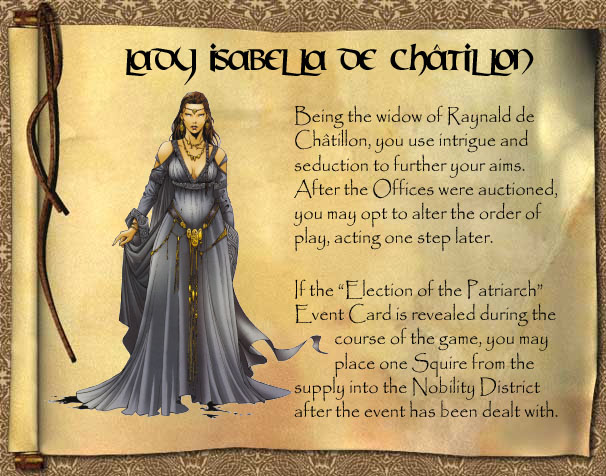
Please note that the character-artwork for this character comes from the thrilling French comic series CROISADE (=crusade) by Jean Dufaux and Philippe Xavier. All rights to these graphics are reserved to the authors. No challenges to their status are intended.
See you tomorrow ! (yawn)
Well, time is flying by! Saturday is over, and when you have finished today's report there will be only one more day to go!
Today I had planned to begin the day with a playtesting session of Mytstery Train by DAYS OF WONDER, a game which had been for sale for some time but which I had not yet been able to playtest. So I made my way into hall 12, and being there at 10 AM when the fair opens actually allowed me to get a glimpse of the masses of people who stream into the halls at this hour.
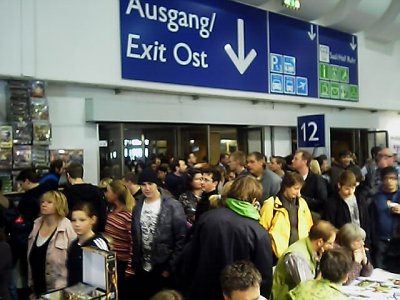
For some types of boardgames the last decade has brought a great leap forwards, and here especially the area of strategy games based on the worker-placement mechanism can be mentioned. However, there also exist some areas where games have seen no substantial change for quite a long time, and one of these games certainly is classic Cluedo which has been part of PARKER's portfolio as long as a can remember. In recent years some variant spin-offs like Cluedo - Harry Potter were released by PARKER, introducing some variant rules like spells or items, but overall Cluedo still remains the best-known murder-mystery game.
Review: Mystery Express, Antoine Bauza and Serge Laget, DAYS OF WONDER, 3 to 5 players
As it seems times are changing, and so Antoine Bauza and Serge Laget could convince DAYS OF WONDER that the time had come for the release of a new contender for the old classic. Being known for their beautiful games design and their fondness of extraordinary topics, DAYS OF WONDER virtually jumped aboard the train and released Mystery Express, a murder-mystery-game remotely based on Agatha Christie's novel "Murder on the Orient Express".
Once again the players are challenged to find out as much they can about a case of murder, but in addition to the three classic categories of culprit, weapon and crime scene the players now also have to find out about the culprit's motive and the time of the offence. One crime card for each category is randomly drawn at the beginning of the game and placed secretly below the gameboard, and it will be the aim of the players to gather as much information as possible to find out the true nature of this "crime sequence".
Mystery Express and Cluedo both share the fact that they are games in which the players have to follow a process of elimination, so that each card the players will see during the game might give a hint at the fact which cards are not part of the crime sequence leading to the murder. Leaving the time of the offence aside, six different cards exist for each of the other four categories, but to make things even harder for the investigating players, each card does not exist once but twice. Thus, the players only can be certain that a certain card is not part of the crime sequence if they have seen both copies of the card in question.
But how will the players see the different cards? Once again skipping the time of the offence, all other cards will be shuffled into a big crime deck at the beginning of the game. From this deck the players will receive a starting hand, but some additional cards also will be placed on passenger and train conductor spaces on the gameboard. The player characters themselves also are present on the gameboard, but they will be placed within different wagons of the Orient Express, and as the players move their characters from one wagon to the other they will be allowed a certain range of actions which will give them limited access to other players' hands of cards.
However, before we have a look at the different types of actions associated with each wagon, let's first examine the general mechanics of the game. Antoine Bauza and Serge Laget have tried to emulate a moving train with their rules, and so the game consists of a total of five rounds in which the Orient Express slowly moves from Paris to Istanbul. At the end of each round the train reaches a station, and the arrival at a station will trigger some kind of event. However, even more interesting is the time when the train is in motion, since it takes a couple of hours to get from one station to the next, and the players will have use this time frame to conduct one or more actions in the different wagons.
When the train finally reaches Istanbul, the players will have to write down their findings on the crime sequence, but they are allowed to skip one or more categories if they are not certain. Points will be awarded for each correct finding, but a penalty is deducted if a player has made a guess which was proved to be wrong, and the player with the highest final score will have won the game. In case of a draw, the players will have to rely on telegrams which they could send from Budapest, the last stop before Istanbul. The player with most correct information in the telegram will be the final winner.
But let's now return to the action aboard the train. As indicated, the players have a certain amount of time available on each leg of the voyage, and they may use this time to visit different wagons and perform actions there. The movement between the wagons is free, but the available actions differ from wagon to wagon. As an example, a player may visit the compartment wagon and spend one hour there. He then may name either his left or right neighbour who then must give him a crime card of the active player's choice. The active player then has to hand a card of the same category to his other neighbour, and so it continues until all players around the table have received and passed onwards a card of this category (players who do not possess such a card must directly pass on the card which was handed to them). Another example is the dining car. Here the active player may spend a number of hours corresponding to the number of players he invites for dinner, and he may name one category of crime card which each of the invited players must show to him.
As indicated, the choice of actions is broader since six different wagons exist, but most of the actions are concerned with different ways to learn about cards held by other players. Since possession of crime cards may change depending on the players' actions, the players will need both a good memory and a feeling for card changes which might be caused by other player's actions. The special composition of the deck of crime cards (remember - two copies of each crime card exist) and the fact that a category of crime cards always can be identified by its backside makes it rather important for the players to ponder which action might suit them best, and in addition the available time frame and the fact that some actions might be helpful to the other players all will influence a player's final decision which action(s) to chose. Overall this kind of decision making strengthens the observation that Mystery Express is much more tricky than its older predecessor, since the need to see both copies of a crime card to be certain that it is not part of the crime sequence requires the players to be of constant vigilance for card changes.
Just reading about this mechanism might bring you to the question how the heck the players should manage with such a chaos, but fortunately enough the authors have kept the chaos somewhat controllable. The players are allowed to keep notes which cards they have seen, and although it is impossible to memorize all player possessions testing has revealed that the task of finding parts of the crime sequence remains manageable. However, players with a good memory certainly are in an advantageous position, and this partly reduces the factor of luck when it comes to naming a category of cards which another player should show. In addition, the different player characters come in quite handy, since they possess different special abilities which should make the game a bit easier for newcomers since they allow a headstart in one of the crime categories. Nonetheless, the players will have to take a considerable initial hurdle upon their first contact with the game, and full enjoyment only can be tasted when everybody is willing to use his memorization skills.
The train ride is further spiced up by several other factors which all contribute to the game's atmosphere. Thus, the players may meet the conductor or one of the two passengers who will board the train at different stations, and all of these characters will exchange a crime card with the active player who has visited their wagon. Furthemore, a tunnel before the stop at Munich will allow the players to have a short glimpse at one of the cards help by both their left and right neighbours, and the events at some other stations will give the players access to the time of the offence cards which were omitted so far. Thus, at three times during the game the players will circle through the deck of time-cards in different manners, and here they must find out which of the eight different crime time cards only appears twice, so that the third card showing this specific time must be part of the time sequence. A rather wacky memory challenge!
Due to its interesting setting and the nice graphic design Mystery Express invites the players to join the train ride over the Balkans. However, it should be repeated here that the players with a liking for memory tasks stand a much higher chance to gather most information on the crime sequence, and so skilful playing alone will not be the key to winning. This leaves the game's final evaluation open for debate, since gaming groups with a liking for such kind of games will cherish Mystery Express for its rather innovative approach, whereas other players might feel that they have been robbed of any substantial means to control their position in the game. Such total rejection seems out of place, but nonetheless Mystery Train stands apart from many other DAYS OF WONDER products due to its rather different orientation.
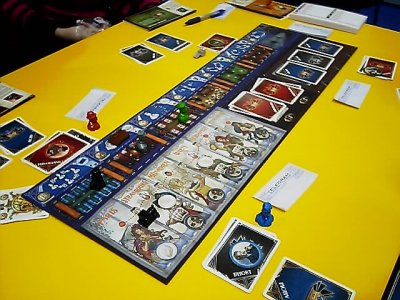
After this somewhat befuddling start into the convention day, I first needed to wander the halls for some time in order to get my head clear. I already had chosen a game for my next playtest, but unfortunately I needed to cross over to hall 4 in order to play it. Hall 4 was at the other end of the fair, and so I slowly squeezed through the masses of people which were moving through the halls this morning.
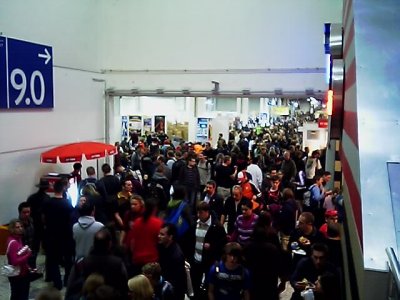
Thus, I was actually quite surprised to stumble upon a booth which sells not only several used games of Full Metal Planete, but the store also offers batches of replacement figures, complete figure sets and even newly crafted wooden boxes including the game itself. In addition, they even sell a bunch of useful extra gadgets like electronic timing devices or gameround counters, and with LUDODELIRE having vanished I wondered how this company seemingly had ended up with production rights for the game. However, the prices for which all this are offered are not really bargain prices, and so the basic game - both the original box and the new wooden box - sells for well above 200 Euro. Still, one thing was most amazing, and this was the fact that the stall actually had about two dozens of the Full Metal Planete - Plateau Modulaire expansion left. These were sold for a moderate price of approximately 50 Euro, and having waited for a long time in order to see an affordable copy of the expansion appear at Ebay, it really left me with a big question mark where all these expansions had been found. I didn't have a clue for this…
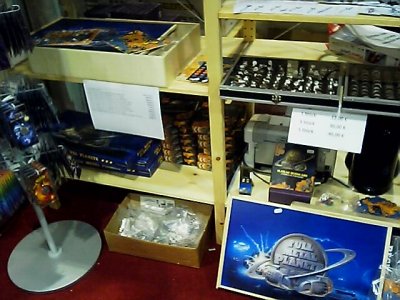
But now let's go for another playtest, since I had finally reached my destination, the booth of GEN-X GAMES down in hall 4. The game Target Earth - Objetivo la Tierra strongly reminded me of a Science Fiction series which I have seen about 20 years ago. At that time German television broadcasted V, a series about an alien lizardmen race which had arrived at the Earth with huge UFO's and came - disguised as humans - on a pretendingly peaceful exploration mission. However, the main actors soon had to discover that the aliens were planning to take over Earth government, and so some centers of resistance developed which tried to fight back the aliens by guerilla warfare.
Review: Target Earth - Objetivo la Tierra, Jacobo Cagigal, GEN-X GAMES, 1 to 4 players
Now it seems that the aliens are back, but instead of claiming to come as friends the lizardmen in Target Earth have just one aim - forceful subjugation. Thus, up to four players have to form an alliance, and they are placed in the lead of resistance bases under control of the military and some scientists which have to try to repulse the ever increasing waves of alien UFOs in order to keep mankind from becoming alien thralls.
The game runs for a total duration of seven rounds, and defeat or victory of the players is mainly decided through the players' performance of keeping as many important countries as possible free of alien influence. During setup a total of eight countries is determined on a semi-random fashion, and these countries will assist the players' alliance with funding which is needed to keep the battle going. On the other hand, another group of eight countries also is determined, but these countries have already fallen under alien control, and so both sides will start the game with an equal sum of equally strong countries (each country group with a value of 24 victory points). A total of 30 countries exists in the game, and so 14 countries actually start the game as neutral countries, and target markers of the neutral countries, the alliance-siding countries and the alliance bases all will be put into a container in order to draw possible targets whenever the next wave of UFO's prepares for an attack.
Each turn is split down into a total of nine different phases, going from the collection of income, investments for research and production over to diplomacy and UFO missions. During these missions the players have to use military forces to stop the aliens either in their approach or in a ground battle, and after all UFOs have been dealt with the players' units finally return to their bases for the end of turn phase in which victory conditions and research results are checked.
As indicated, the income of the players depends on the number and wealth of the countries siding with the alliance, and the players may increase their income by recruiting more countries to their side. Such recruitments may be made in the diplomacy phase where the players have to decide on one country in which a diplomatic mission is made, and two dice are rolled in order to see whether the diplomatic mission was a success. Depending on the size of the country, a certain result must be rolled, but if the alliance successfully gathers a growing number of countries to its side this dice-roll will receive a positive modifier because the unanimity of the alliance-siding countries will make it easier to sway the opinion of the government of the country which is target of the diplomatic efforts.
The aliens on the other side will not waste time on diplomacy - they want to impress by force. Thus, they will try to pierce the alliance defenses by use of UFOs, and whenever an UFO reaches a target country a dice-roll is made and modified by the size of the attacking UFO. Similar to the diplomatic approach of the alliance, a certain result must be rolled, and a success will mean that the country sways one step towards the alien side. (I.e. alliance-siding countries become neutral, neutral countries go over to the alien side). Whenever a country joins or leaves one of the warring parties, both the alliance income and the current levels of victory points of the alliance and the aliens need to be adjusted according to the country's value, and it is the players' collective aim to end the seventh round with more victory points than the aliens.
Returning to the alliance income, the players can spend this money on collective research and on building their individual bases and forces. Thus, after the income is collected at the beginning of each turn, the players can decide to invest money to research a new technology, but as a nasty twist the technology does not become available right away but instead the players have to wait till the end of the round to see whether their efforts were successful. The result of research is not based on luck, but instead the players will have to possess a number of laboratories as required by the researched technology. Furthermore, the more advanced technologies require the players to possess knowledge about the aliens, and such knowledge only can be gathered if the players successfully battle alien invasion forces.
Three of the four technologies available for research deal with the different types of troops available to the alliance: Fighter jets, tanks and infantry squads. The higher the research level in each category, the better will the units of all players perform in combat. There is no need to update troops, since all kinds of units automatically are considered to be updated to match the current research level. However, to build up a military force, a player first has to invest in his base, since the purchase of any type of unit (fighter jet, tank, squad) first must be preceeded by the purchase of a matching base building. So, the players need to purchase hangars, garages and barracks where there units can be placed, and as a further prerequisite the maximum number of buildings for each of these categories is limited by the number of warehouses a player has added to his base.
The money to make individual purchases comes from a player's starting allowance, and furthermore the part of the alliance income which was not spent on collective research is equally shared between all players. This money can be used to improve the players' bases and purchase military units, and the players then can use their military in their valiant defense of Earth.
The military campaign develops the same way during all seven rounds. First, new target markers are drawn from the container with the markers of the neutral and alliance countries and the player bases, and then an approaching UFO is drawn for each of the drawn targets. The UFOs also come from a container, but the composition of this UFO container will change during the course of the game since ever-stronger UFOs will be added to the mix at the end of specific rounds. When the targets (countries and / or bases) and the attackers have been determined, the players need to decide how they will meet the current alien threat. They now have to deploy their fighter jets to attack the approaching UFOs, but they also have to check whether they have build enough radar relays in their bases to track and attack even the far-flying UFOs. Otherwise the choice of UFOs which can be attacked will be limited. The ensuing battles then will be resolved by dice rolling, with the result of each battle being modified by the size of the UFO, the number of attacking fighter jets and the current aircraft research level of the alliance.
Chances are high that the players will not be able to deal with all approaching UFOs so that some of the UFOs will be able to deploy their ground forces. Now the players once again have to chose where to send their ground troops, and here they can split their troops between countries currently under attack and countries which are already cooperating with the aliens. For the transport of troops the players need shuttles which also are stationed at the player bases, and when all troops have arrived at the battle sites the players once again take out the dice to fight all individual combats. As mentioned earlier, in case of any alien victory the aliens will try to force the target country into cooperation so that alliance countries may become neutral and neutral countries may switch to the alien side. An alliance victory in an alien-siding country will make the country revert to neutral status, and an alliance victory in a neutral country will lead to a free diplomatic attempt for the alliance to sway the opinion of the target country to pledge allegiance with the alliance. And not to forget: the alliance will receive one point of alien knowledge for each ground victory, and these points are desperately needed for research!
Each round ends with some cleanup efforts, and so the players have to return all their units back home to their bases. However, if the base actually was attacked by an UFO which could not be defeated, some of the buildings at the base might have been destroyed. In this case some of the homecoming units may not find a matching hangar / garage / barracks, and in this case all units without matching building must be scrapped. In addition, the players now check whether they have enough alien knowledge and remaining laboratories to finish their researched begun earlier during the same round, and only if all requirements are met the new technology level is finished. Otherwise, all the money invested into research this turn will be lost! Finally, the container with the target markers needs to be updated to match the results of the current round, so that target markers of countries which have fallen to the aliens will be removed, whereas freshly freed countries will be added to the container.
There is a chance for an instant victory if either the alliance or the aliens have acquired more than 50 victory points, but the game finds it regular end after the 7th round. Now the alliance needs to possess more victory points than the aliens, but in addition the alliance also needs to have mastered the fourth level in their research of alien technology, the fourth technology which can be researched by the players apart from the three military technologies. Only if these two requirements are met the alliance can claim victory, so that all other constellations will lead to an alien victory.
This short description of Target Earth - Objetivo la Tierra might sound more complicated than needed, but I wanted to make sure that the general feeling of the game comes over with some details. However, at this point I should add that the game includes a few other things which offer even more finetuning. On the one hand all players will get a constant supply of alliance cards, and each player is allowed to use of on his cards each round. These action cards can be used for a number of purposes like the upgrading of an unit to "elite" status, improving research results, diplomatic attempts or even the gathering of additional alien knowledge. All these cards are helpful in the one or other way, any they are needed to counterbalance the otherwise frightening alien forces. However, there also exist some advanced rules which add real competition to the game, since now each player receives a hidden agenda card which will list an aim which the player needs to pursue in order to win the game. Thus, the players record individual scores of victory points in the advanced game, and these points will be awarded for their individual performance in combat and for other actions. Furthermore, each player receives his own unique faction, and the four available factions are the airforce, the army, the intelligence and the diplomatic corps. Each of these factions has its own strength and unique ways to score additional victory points, and so the advanced game puts up a challenge which is rather different from the basic game. Whereas the players in the basic game all need to follow the common goal, the advanced game requires the players to act selfishly and thus endanger the whole mission of defending Earth. The players are required to keep a good balance between contributing to the common goal and following their own aims, and so their whole playing style becomes quite more individualistic.
Whereas the rules of GEN-X GAMES last year's hit Luna llena - Full Moon sometimes were a matter of debate and disputed amongst gamers, I scanned through the rulebook of Target Earth - Objetivo la Tierra while I was preparing for the SPIEL, and these rules seemed to be much more straightforward. In addition, as this review should have shown, Servando Carballar of GEN-X once again has succeeded in finding a game with a somewhat uncommon topic which has a good potential to fascinate players for quite long playing hours. While the basic rules offer team-orientated interaction, the advanced rules may be used for competitive play and so the whole setting of the game changes dramatically. As a matter of fact the rules are not changed on many points, but author Jacobo Cagigal did well to include both variants since the game now can be experienced from two rather different perspectives.
Another point worth mentioning is the nice interaction between the buildings in the individual player bases and each player's military options. It seems well-matched to put up a correlation between the buildings and the different military units, since the players need logistics to keep the fight going, and it also becomes rather crucial to defend a base against an alien attack since the destruction of buildings might lead to the abandoning of troops. In a way, this reminds a bit of classic PC-games like Dune 2 or Warcraft (the old first edition) where the players first had to build up some infrastructure before they could start a military campaign, and here the author has elegantly integrated these logistical efforts into a quite new scenario. And, of course, there are also major similarities with the UFO: Enemy unknown bestselling PC game from 1994. It seems that Jacobo Cagigal must have known this game, since there are many elements in Target Earth which were present in the old PC game as well.
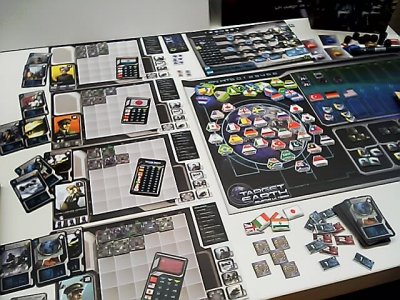
The morning had long passed when I had finished with Target Earth, but I was quite interested to know what Ralf had been playing so far. So, let's have a look at his report of the day!
|
Today I came a little bit delayed to the convention. The reason for this was a marten. The animal has made itself comfortable in the engine of my car and had nothing better to do than nibble some of the more or less important cables. I tried until now three different car dealers, but no one had the right replacement part. So I am forced to try something myself... The delay is one reason why I only can present you only one review today, but I hope that I will catch up with more tests tomorrow again... The other reason that I only have tested only one game today is the duration of my chosen game, since it took quite long to listen to the game rules and then play the whole game through. The new game from GIOCHIX, named Rio de la Plata, is settled at the identically named river in the year 1536. At this time the city of Buenos Aires was founded, but from the start on the settlers had huge problems with the natives. About 50 years later, the city was rebuilt and again the natives were not happy about that. Worse still, the English Crown paid Corsairs menacing the Spanish settlers. Players represent the heads of Spanish families and must cooperate on the one hand to defend the city and compete on the other hand for high reputation and political offices. The game has three different phases per turn. First of all a player has to place his workers. He can do so in three different areas. In the middle of the board there is a 10x16 square grid that represent the city of Buenos Aires around the Plaza Mayor. In the first possibility the player may place his workers in this city map to build new minor buildings. Minor buildings can be huts, houses, stonecutters, markets and a lot of other possibilities. Some of these buildings can be activated for a special effect in the second game phase. For example a stonecutter can be used to get three stones out of one. To use this function, workers must be assigned to these houses again. Because workers must be placed in a space adjacent to a player´s house, the city map is filled from the starting zone to the outer edges with progressing time. As another possibility, workers may be placed on more important buildings outside the city. All these major buildings have a construction grid on the board. A major building can be built with the help of several players. Victory points are given to every worker once a building is completed. But the biggest advantage goes to the player who places the last worker, because he may place the corresponding building tile on a district of the board of his choice. So he can choose an area where he possesses the majority of minor buildings. Each major building gives the players a positive effect during or at the end of the game. Finally a player may place his workers on some special areas on the board like the mine, the ship or the game´s order. For this he can use special actions like receiving a stone or wood or silver coin in the corresponding phase. All of the workers must be divided very carefully, because a player only has a limited number of workers available. So if for example a player places a lot of workers in the major buildings he may get short of workers, because these workers are not set free, until the building is finished. The effect of the workers (e.g. a production or a building creation) takes place in the second phase of the game. Some of these actions have corresponding costs, too and are not performed until the player has paid these costs. The next phase plays a major role in the game, because in this phase war can take place. First of all there is a check, if a war takes place. Two dice are thrown and compared to the enemy track, which is advanced forward during the game. If a war takes place, one player acts as the attacker. His goal is to destroy as many of the buildings on the city map as possible, for which he gains victory points. . All other players must try to defend the city. To do so they should have some defenders (workers) on the board and can bring more defenders with money. Additionally they can use the Fort´s cannons, if the Fort was already built. Defenders get victory points for attacking tokens they have destroyed, but also for own tokens that are killed in the combat. So there is a possibility too sacrifice workers for getting victory points, a fact that is a little bit confusing at the beginning, but turns out to be a very tactical element in the game. Combat results are determined by the simple majority rule. In the case of a standoff, both groups of tokens are removed. All in all this seems to be very simple. And the single actions indeed are simple. In reality the combination of the actions are very tactical and strategic, because it is the right choice of developing the different types of buildings that wins the game. The game lasts at least two hours, so it is definitely not a family game. The war element is a game in the game, very interesting and a fantastic way to give the game a different direction. If you are interested in strategic city development games and if a long game duration does not discourage you, you should have a try of Rio de la Plata. Once again sorry for not providing any more news today, but as I only had a few hours at the show the playtesting of Rio de la Plata took up most of my day. So, I guess you will read more from me tomorrow. |
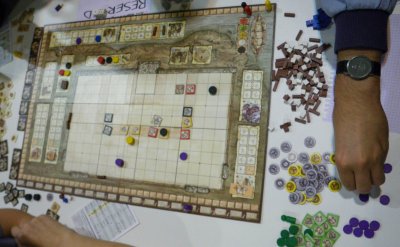
Well, my two long playtesting sessions also had taken up quite a bit of the day, and since I had planned to do another major playtest on the late afternoon I needed to bridge the remaining time. While testing Phantom League at the TUONELA booth yesterday I had actually spied an inconspicuously looking prototype gamebox standing in a corner, and this plain white box bore a small image and the title M.U.L.E.. Once again I had to dig deep in my memory to come up with yet another experience from my old days as a Commodore 64 gamer, and I fondly remember a production and trading game called M.U.L.E which could be played by up to four players.
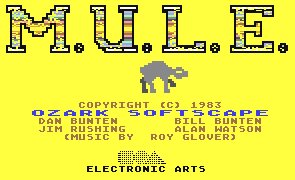
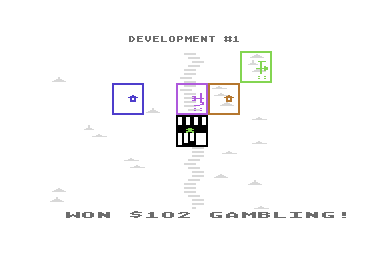
The old graphics look amazing, don't they? Even more amazing is the fact that many people consider M.U.L.E to be the best computer game which was ever created, and even some famous computer games designers still call M.U.L.E an inspiration and an ideal for other games. You doubt my words? Then you might want to visit the M.U.L.E-page on wikipedia!
So, I met with Jussi Autio at the TUONELA booth, and with a group of three additional visitors I embarked onto a journey to visit the Planet Irata (read this backwards as well!) to set up a settlement and a mining operation for the universe's most valueable mineral: Crystite.
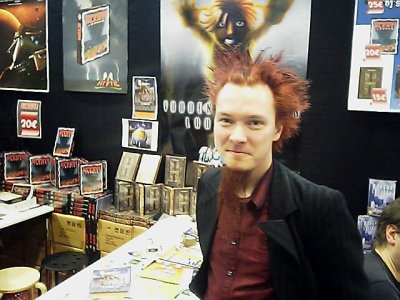
The players start the game with just a single parcel of land and some food and energy supplies plus a bit of money, and usually they will have chosen a river valley parcel for their start since the parcels in the fertile river valley will give the best yield of food resources in the game. The players have added the parcel tile which they had chosen to their own estate boards, and here all other parcels they acquire will be placed as well. However, in order to receive any kinds of resources during the harvest phase of a turn the parcels must be operated, and that's the time when the M.U.L.E.s (Multiple Use Labor Element) come into play. So, the players must use money to acquire M.U.L.E.s from the manufacture in the planet's only city, and once a M.U.L.E. is bought it can be placed on any of the buyer's empty parcels in order to start the production there.
As most parcel tiles can produce different types of goods, the tile must be rotated so that the currently produced type of goods is pointing upwards, and so the players will start to gather new food and energy, but also Crystite and the planet's fourth commodity which is called smithore. Food is used in the game to gain actions during a player's turn, and energy is needed to operate M.U.L.E.s in parcels which do not produce energy. Crystite and Smithore both must be sold to the city stores, but whereas Crystite instantly is transported off Planet Smithore will be stockpile at the M.U.L.E.-manufacture so that new M.U.L.E.s will be produced from it.
The much adored masterpiece of the computer game was the mechanism on which the prices for all four types of commodities were determined, and in simple turns the market mechanism simulated a system of offer and demand which was triggered through the buying and selling actions of the players. This system has been transferred perfectly into the prototype boardgame by using a variable pricing scale, and the players will try to make as much money as they can be selling goods to the market when prices go up.
However, the boardgame does not just emulate the core mechanism of M.U.L.E., but as far as I can remember nearly all elements from the computer game have found their way into the boardgame as well. So, the players start with different races, they have to explore parcel tiles to find out whether the tiles possess any Crystite deposits, and even the events which cause some unexpected twists in gameplay are included. However, part of the event cards are played in a somewhat deterministic way, so that especially positive events will reach players who need them most. So, the game leaves some opportunities to catch up again after making an error or two, but still the playtesting revealed that a player who has played rather cleverly even will not be stopped by the events alone.
Overall, I was rather smitten with this faithful implementation of the old computer classic, and as Jussi told me the graphics which were shown in the prototype will be fully exchanged by professional artwork of which he showed me two samples. At the moment TUONELA still is looking for a partner to publish this game, and I really hope that this will happen soon since I think that M.U.L.E. needs to be on my gaming table as soon as possible!
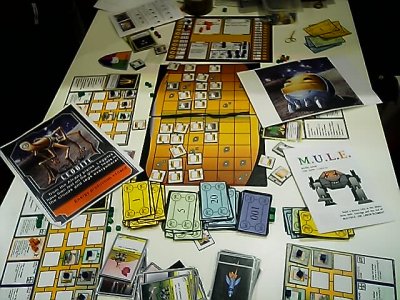
As a matter of fact I was tempted to stay at the TUONELA booth to continue my playtesting of M.U.L.E, but as I told you I had planned to playtest one more big game this afternoon. So, I changed over once again to Hall 12 where I visited the booth of EGGERTSPIELE, and here I started a playtesting session of Grand Cru.
Review: Grand Cru, Ulrich Blum, EGGERTSPIELE, 2 to 5 players
Sometimes the big studios of Hollywood stumble upon a rather interesting scenario for a new movie, only to discover that another studio is doing a rather similar film at the same time. However, such a phenomenon is not limited to the world of movies - it may also happen in the world of boardgames. And so, not less than four different games focusing on the cultivation and bottling of wine were announced to be presented at the SPIEL 10. One game which had not made it because of some last minute production delay was Vinhos by Vital Lacerda, but fortunately for EGGERTSPIELE Grand Cru was ready to be presented and sold at the SPIEL.
Although the topic is not totally new (I remember at least one GOLDSIEBER game which had something to do with wine), I nonetheless wanted to join in for a tasting, and so I decided to have a look at Grand Cru since EGGERTSPIELE is rather well known for their lavishly equipped strategy games. Thus, it was no question for me that I would give their interesting looking game a closer examination.
In Grand Cru, each of the players receives his own newcomer vineyard, and as it is common with a new startup-business, the players have to start with a few bank loans which they need to get their business going. It is up to each player how many loans he wants to take out at the beginning of the game, and for each loan a player will receive 7 Francs for his cash box. During the course of the game the players will strive to pay their loans back, and the game ends in the round in which the first player succeeds in paying back his last open loan. Then the value of the vineyards and equipment of all players will be evaluated, remaining loans are substracted, and the most wealthy player will have won the game.
Each round/year of the game starts with the revealing of new vineyard tiles, and these tiles may show either grape-vine or equipment which might be added to a player's vineyard. All new vineyard tiles are openly revealed, and in their turns the players have a chance to make a bid in order to acquire one of these tiles. However, Grand Cru actually works with a somewhat uncommon auctioning mechanism, since an auction is not solved all at once, but instead the placing of an auction bid may be chosen as an action for a player's turn.
During their turn, the players may perform one action out of a broader choice of actions. As indicated, one of these actions may be to put one of the vineyard tiles for auction by placing it at a free auction slot on the gameboard and marking the amount of Francs bid for that tile. However, in order to win this auction the player will need to wait until his next turn, and the vineyard tile only may be taken (another action) if no other player has placed a higher bid on the same tile (another action). Faster and more certain is a direct purchase, but it costs a player the full amount of seven Francs to make such a direct purchase.
When a grape-vine is purchased, the player adds it to his own vineyard display, placing a properly coloured wine-cube on the tile. All grape-vine tiles of the players receive a new wine-cube at the beginning of each round/year of play - but only if the wine-cube from the previous year has been used, since each grape-vine can only hold a maximum of one cube. Wine-cubes may be harvested, and if a player decides to use his turn for a harvest action he may take one of the wine-cubes from one of his grape-vine tiles and place it into the first barrel in his wine cellar. In that barrel all the wine harvested with multiple harvest actions during the same year will be stored for ripening, and at the end of each year all wine cubes in the cellar will be moved forwards for one barrel to simulate the ripening process.
Depending on the sort of the wine (5 different sorts exist in the game), the process for the wine to become ready for sale may take a few years, and when the wine is ready the players can chose another action during their turn - selling wine. With this action all cubes of the same wine sort from one barrel can be sold for a price indicated by the wine market chart on the gameboard. The player will receive the indicated amount of Francs for the wine, and afterwards the price of the wine is lowered for one step. However, a player also may use his turn's action to increase the price of one wine on the wine market chart by one step, thus getting a higher sales price for one of the following turns. On a sideline, it should be noted here that all sold wine cubes are not directly returned to the stockpile, but instead each player places the sold cubes within his own holding area on the main gameboard. Here the cubes are visible for everybody, and the number of wine-cubes sold will have an impact on the player's positioning for the endphase of each year/round - the annual wine festival.
However, before the wine festival can take place, all players have to finish their actions. As indicated, the players take alternate turns with each player performing only one action per turn. A minimum of four actions is guaranteed for each player, but there is a high chance that a player will not be able to do everything necessary with just four actions. Thus, the action-phase continues until either all but one player have declined to perform any more actions for this year, or until one player has harvested his last wine-cube from his grape-vines. Either way, both of these events lead to an end of the action phase, with the remaining active player(s) only getting one more action before the phase is over. This mechanism puts an immense amount of pressure on the players to keep their wineyards organised and to work economically with their actions, since otherwise a fast player might bring a forced ending upon players with longer, inefficient production chains. Although this kind of player interaction is still indirect in a technical sense, it keeps the players strongly focused on the other players' actions, since there will be a lot of speculation whether a player might count on getting some more actions, or whether a nasty competitor with a streamlined production might bring an abrupt, painful end to all further actions for this year.
A possibility to work economically certainly is the planting of several grape-vines of the same wine-sort, since all cubes of the same colour from the same barrel may be sold from the cellar with just one selling action. However, while this certainly makes the whole business more profitable, the wine festival at the end of each year awards players who take the risk to invest in more than one type of grape-wine. As said earlier, all sold wine-cubes from a year are put into a player's holding area, and for the wine festival the player's need to check which player has sold most cubes of each of the five different sorts of wine. The players who have sold most cubes for each kind of wine receive an amount of prestige points, and when all five wine sorts were checked the wine-cubes from the holding areas are finally discarded. However, the players' actions are not really over, since the prestige points awarded at the wine festival can be turned in by the players for special actions - either directly after the wine festival or following a wine festival of a later year. The prestige points give the players access to a range of special actions like an additional grape harvest action or a wine selling action, the selling of a primeur (wine has not yet reached its full ripening), the sale of all grapes remaining on the grape-vine as grape-juice (cheap, but better than wasting the wine-cubes), changing of wine prices or even getting some additional Francs. Here the competition is high, since each action available for prestige points only will be available to one player each year!
Talking about special actions, we had not yet examined the vineyard tiles showing equipment which also are available for auctioning or a direct purchase. Just like grape-vine, a purchased equipment tile is also added to a player's vineyard, and each equipment tile may be used once a year for a special effect. Some of these tiles can be used to enhance the efficiency of a player action (selling more wine from the cellar, harvesting two cubes instead of one etc.), or they might actually give the player access to a new kind of action (e.g. the refinement equipment allows a player to move all cubes of one wine sort from one barrel in the cellar to the next barrel, thus bringing the wine faster towards its ripening point). In comparison to the special actions available from the prestige points, the equipment tiles have the advantage that they may be used each year after they have been purchased, but although the range of actions is somewhat comparable there are some actions which can only be triggered through equipment or prestige. So, you can only become the new start player through the use of prestige, whereas the assemblage (exchanging different kinds of wine cubes) only can be found as an equipment tile.
On first sight Grand Cru compares to quite a few other build-and-development games on the market, since each of the players is concerned with the building and management of his own vineyard. New grape-vine and equipment is acquired through auctions, and everybody strives to purchase the vineyard-tiles which are fitting best into his current strategy. However, as mentioned earlier, Grand Cru offers a higher degree of direct and indirect player interaction, since the competition between the players is fired especially through the varied number of actions available each turn. A player who finishes his harvesting quickly can exert pressure on his competitors, and this leads to all players taking a lively interest in the actions and possible moves of the competition. You actually try to second-guess the other players' actions in order to plan your own turn, and this is done at a very high degree which is uncommon to many other build-and-development games.
In addition, Grand Cru offers some twists and tweaks which incorporate the management of a vineyard quite elegantly, and as examples both the ripening process of the harvested wine (the barrels in the cellar) and the annual wine festival can be mentioned. While the delayed usage of acquired goods is not new (games like Macao or The Circle use a mechanism of delayed availability), the annual shifting of wine cubes from barrel to barrel is both thematically coherent and strategically challenging. The wine festival on the other hand awards players taking risks by investing into different sorts of wine, and in addition the prestige points acquired at the festival offer yet another means of strategic planning, since they must not be used in the same turn but instead can be saved for a grand coup at a later time. Thus Grand Cru makes high demands on the players' timing abilities, but it is especially this challenge which makes the game rather enjoyable!
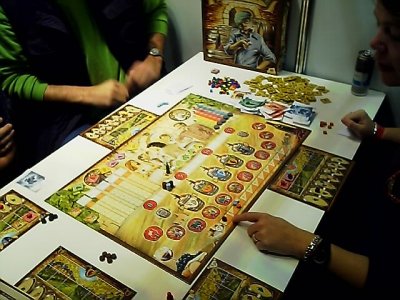
After finishing this last playtesting session I decided to call this a day and go home, but on my way out I bumped into Dale Yu from BOARDGAMENEWS and his friend Valerie Putman. I have met them at some points over the last few days, and now they also were enjoying their final hours here at the convention before their flight back home will leave tomorrow morning.
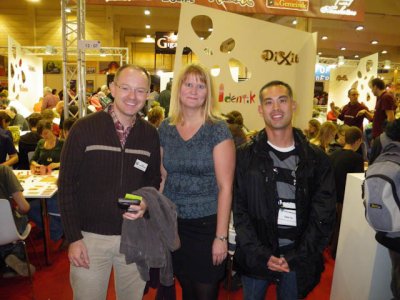
Something missing? Yes indeed! So here we go with the new character sheet for Jerusalem - The Kingdom of Heaven.
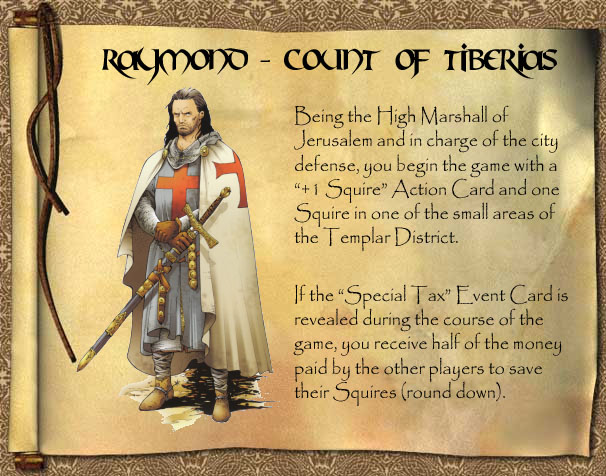
Please note that the character-artwork for this character comes from the thrilling French comic series CROISADE (=crusade) by Jean Dufaux and Philippe Xavier. All rights to these graphics are reserved to the authors. No challenges to their status are intended.
And of you want to win some of the mini-expansions and goodies distributed by the publishers here at the SPIEL, don't fotget to sign if you have not already done so!

See you tomorrow for the grand final!!!
Hi folks!
A week can pass really fast, and it's somewhat unbelievable that the SPIEL '10 had closed its gates today at 6 PM. However, once again it has been a rather entertaining day in the convention halls, especially since my wife Nicole actually joined my playtesting activities for the whole day. So, with today being Girls Day, Nicole actually had superior rights to pick the games today. However, don't get worried, we are not going to see the Filly Princess Game, but actually our tastes are rather alike and so there will be some interesting games I can tell you about!
In order to get a good overview Nicole and I first scouted the halls and the new games show, deciding which games we wanted to playtest. However, we actually stopped rather unexpectedly at the entrance of the new games showroom because a game had appeared there which ad not been there on the previous days (well, at least I cannot remember it standing there). They game I am talking about is Weykick, a wooden soccer game which comes on an elevated pedestal so that players actually can put their hands below the game. This space is needed, because the players actually need to operate two magnets which will give control of the two the soccer figures, and starting a spontaneous game Nicole and I soon were competing for goals. The game is exquisitely crafted, and the mechanism with the magnets works absolutely smoothly so that the players just need to focus on their skills and reaction to have very tense, entertaining matches.
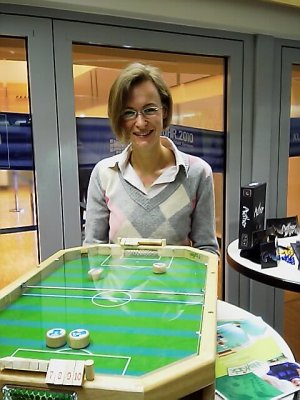
After finishing our match (Nicole won) we also scanned through the rest of the newsshow and marked a few games for playtesting, but before going for the first real boardgame we first visited the WEYKICK-booth in hall 12 in order to find out how other players reacted to the game. At the booth we found an enthusiastic crowd playing the weykick-games, and we also learned that the game we had played at the newsshow only is one version out of a couple of different versions. So, there are games with little player figures, and even other kinds of sports like tennis (using ramps) could be found at the booth. However, due to the high manufacturing quality of the games the price was not at bargain level (starting at approx. 120 Euro), but this seems justifiable because the games are very solidly handcrafted.
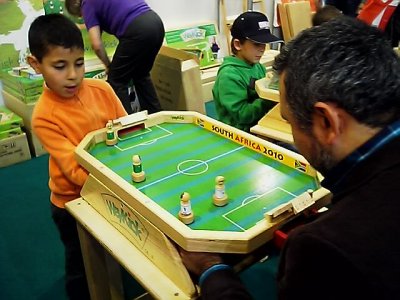
As a coincidence, the booth which we wanted to visit for a gaming session also could be found in hall 12, and so Nicole and I went over to the big ASMODEE playing area where we hoped to find a free space at one of the YSTARI tables for playing their new game Mousquetaires du Roy. Unfortunately, all tables had games in progress, and so we started to round the booth because we also wanted to see a game from GAMEWORKS who are another associate of the ASMODEE distribution group. We were more lucky here, and so we got two free spaces at a table which was setting up for playing Tikal II - The lost Temple, and so Nicole and I sat down quickly in order to start our first boardgame of the day.
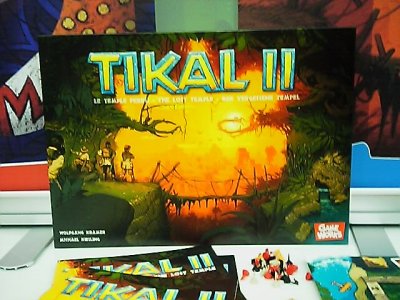
Review: Tikal II - The lost Temple, Wolfgang Kramer & Michael Kiesling, GAMEWORKS, 2 to 4 players
A few years ago the successful authors-team Wolfgang Kramer and Michael Kiesling and their travel-agent RAVENSBURGER have invited us for an awards-winning trip to the South American jungles, searching for the famous pyramids of Tikal. However, whereas our first trip to the region was concerned with the sheer discovery of pyramids, we now have returned for yet another project - the exploration of a pyramid. The travel-agent has changed to GAMEWORKS, but otherwise our new expedition runs under the title of Tikal II, a fitting reminder of our former activities around the pyramids.
The exploration of a pyramid or any other kind of dungeon always brings up some fond memories of dungeon crawler games, but whereas the typical dungeon crawler usually offers a load of random events and dice rolling, such an unpredictable playing mechanism would be unsuitable for a game who claims to be the successor of a former SPIEL DES JAHRES winner. Thus, Wolfgang Kramer and Michael Kiesling have tried to create yet again an exploration game based on tactics instead of luck, and the result of their efforts has been beautifully reproduced by the publishing team of GAMEWORKS.
Once again the players take the roles of explorers, and during a timeframe of two rounds (months) the players try to explore the biggest pyramid of Tikal and score victory points through their different discoveries. During the two rounds of play the players take turns in a fixed player order, going clockwise around the table in the first round and anti-clockwise in the second round. A round has a fixed number of turns for each player, varying between six and eight turns depending on the number of participating players.
During their turns, the players will have to go through two phases - canoe movement and exploration. The canoe movement takes place on a river running outside the pyramid district along the outer edge of the gameboard, whereas all exploration is done within the pyramid district at the center of the board. But let's examine each of these phases with some more detail…
As indicated, the river for the canoes runs along the outer edge of the board, and distributed along this river are six minor excavation sites which the players can visit. At the beginning of each of the two rounds of play a random choice of action tokens is openly placed next to each of the excavation sites, and the players can freely decide how many sites they want to move forwards with their canoes, or whether they just want to remain stationary for the turn. If they want to move their canoe, the movement must always be clockwise (following the river current), and it is limited to a maximum of 5 steps. Thus, the option of either movment or remaining stationary allows a player to visit any of the six minor excavation sites within the scope of just one turn, but it should be noted that the players cannot fully round the gameboard within just one turn. This is important because two floatplanes are towed at different positions along the river, and these planes need to be visited while moving along the river if the players want to get rid of collected treasure tokens.
However, returning to the action tokens which can be found at the excavation sites, a player always must make his canoe movement in a way so that the canoe ends up at a site with at least one action token left. The player then takes possession of one of the remaining action tokens which can be found at that particular excavation site, and he is entitled to all benefits displayed on the token. As a matter of fact, the action tokens contain quite a variety of different benefits, ranging from keys of different colours over secret discovery cards, victory points and room placements to secret passage tiles. As indicated, the player is allowed to collect all benefits which can be found on the action tile, and whereas some of the benefits must be instantly used (room placement), some others may be saved for a later point in the game.
The performance of the action tile ends a player's canoe movement phase and begins his exploration phase. Looking at the center of the gameboard, we see a huge pyramid which is made of hexagonal spaces. Ten spaces showing hexagonal room tiles are printed on the board and thus revealed directly at the beginning of the game, whereas all additional room tiles come from a random stockpiles on the gameboard. The new rooms either may be ordinary rooms, altar rooms or the treasure chamber, and the drawing and placing of both kinds of rooms (ordinary and altar) is triggered through a player who chooses an action tile (during his canoe phase) which displays the corresponding type of room. The new room then is drawn and placed at the active player's choice within the pyramid, thus slowly discovering the interior of the huge structure. The treasure chamber is dealt with somewhat differently, since its placement is not triggered by choosing an action tile but instead it is placed on the last free hexagonal space within the pyramid.
A quite important feature on all the room tiles are the doors, and the doors on each tile will match the colour of one of the five different types of keys which can be found in the game. Each player starts the game with two keys of his choice which he places in his backpack, and as you might guess keys of a matching colour are needed to go through a door of that particular colour. However, the keys are not discarded while passing through such a door - the simple possession of the key is all that counts.
In addition to the two keys which the players receive at the beginning of the game, additional keys can be acquired through the choice of action tiles displaying a key, but whenever a player receives a new key he will face the hard choice to place the key either within his backpack or at his treasure stockpile. As indicated, keys within a player's backpack are used for passing through matching coloured doors within the pyramid, and in addition a key from a player's backpack must be discarded whenever the player's canoe comes to a certain point on its way around the gameboard. At that point the canoe needs to be carried because of a waterfall, and the carrying action requires the player to discard one of his hard-earned keys (or to lose 10 even harder earned victory points). On the other hand, all keys placed at a player's treasure stockpile will bring victory points during the evaluation which takes place after each round, and the greater the variety of keys at the player's treasure stockpile the higher will be the yield of victory points. However, the choice of placing a key into the backpack or at the treasure stockpile must be made upon obtaining the key - and the choice is final!
So, the player's explorers within the pyramid will need keys to go through doors, what other rules are applicable for movement? It might be surprising, but there is no limitation in terms of movement points or something similar, but instead each player is allowed to move his explorer as far as he desires, even leaving the pyramid and entering again through a different door all can be done within the same turn. As indicated, the only limitation are the keys, since an explorer only can be moved from room to room using doors. Here the tricky part of the game begins, since the players will have to find routes to reach the more valuable rooms, and so a player usually places new rooms in accordance to the keys found within his backpack.
After moving his explorer, the player is allowed to start an excavation in the room where the movement has ended (provided that the player did not already make an excavation in this room). The player takes a flag from his stockpile and places it into the room to mark the excavation, and if he is lucky he even can cover a symbol showing victory points or another bonus with his flag. In case of victory points the player instantly earns these points and marks them on Kramer's victory track which runs in this game along a wall bordering the pyramid district. However, even if the victory points of a room are already covered by another player's flag, an excavation still may be useful, since additional victory points can be scored for each room of the same colour in which the player has made an excavation in former turns.
If a player has obtained a secret passage marker through an action token, he may chose to use this marker to create a temporary passage within the pyramid from a room to a neighbouring room. The player may move his explorer through the passage, either continuing his movement from the room after the passage or stopping there to make an excavation. However, in the latter case there is even an option for a direct retreat through the passage to prevent the explorer from getting stranded without matching keys (a situation which otherwise would be penalized by a loss of victory points). In addition, a secret passage also may be used to enter one of the external "secret rooms" within the pyramid district. These secret rooms are located outside the pyramid, but they contain a possibility to score victory points just like the ordinary rooms within the pyramid.
The altar rooms and the treasure chamber which is placed close to the end offer several placement points for flags, so that even players arriving at a later point still have a chance to place their flags as bonus spaces. As indicated, these bonus spaces may offer victory points, but it is also possible that a player will be allowed to take a secret discovery card or a treasure token.
There exist five different kinds of treasure tokens, and for understanding their use we have to remember the floatplanes towed at two positions along the outer river. Whenever a player's canoe passes one of these floatplanes a player is allowed to exchange all treasure tokens of one kind for victory points, and the value of these tokens is decided through a treasure value indicator on the gameboard. The player then hands the treasures to the bank, adds the victory points to his score and rotates the treasure value indicator, thus changing the value of the different kinds of treasures for the next player who wants to make an exchange.
Finally, the secret discovery cards once again give the players access to a wide range of benefits. Thus, a player may get a free canoe carrying action, more valuable or additional treasure deliveries at a floatplane, and extra exploration action etc… The card can be kept in the player's possession and played at his own discretion, probably timed for the best moment.
There are a few more rule intricacies which will not be mentioned here, but what you should see after reading the previous paragraphs is that Tikal II has considerably more playing depth than its predecessor, since the game offers a wide range of scoring possibilities which must be kept under surveillance to get a good chance to win. Placement of flags, collecting keys, exchanging treasures, visiting secret chambers and even the sheer number of already explored chambers all may have an impact on a player's final scoring, and this variety of scoring possibilities actually might seem to be a bit overwhelming for a novice player. However, on the other hand it is exactly this variety of scoring possibilities which allows a player to develop a tactical approach and to make an attempt to plan his following turns, since there is a probability that not all of a player's plans will be spoiled through the interfering actions of the other players. And to increase the tactical level even more, the game makes use of a "controlled drawing mechanism", thus allowing a player drawing treasures, new rooms or secret discovery cards to draw the top three treasures/rooms/cards from the deck, keeping one of them and placing the other two back onto the appropriate deck. This considerably increases a player's control over his own destiny by reducing the otherwise contra productive drawing luck.
The players will be hard pushed to optimize their yield of victory points on their way through the pyramid, and the only similarity between Tikal II and a typical, old fashioned dungeon crawler is the somewhat lonely way of the player's explorers through the pyramid. Player interaction is only reached on an indirect level by the competition for the best exploration sites and action tokens, but otherwise no direct interaction takes place. However, with the aforementioned rules and mechanisms falling into place, the game offers a rather solid and mature tactical challenge, and in games of this category more direct player interaction is not really missed. Thus, take your topee and machete if you are in for a trip to the South American jungle, and don't let the colourful look of the gamebox and the playing pieces fool you - there is a serious task ahead!
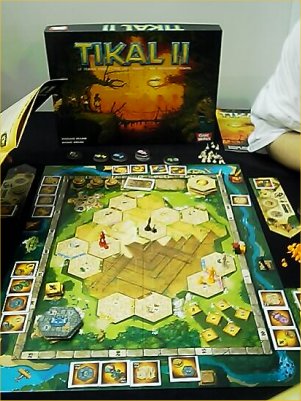
Getting up to check the YSTARI-tables once again for an opportunity to play, Nicole and I did not get far but actually stopped at the booth of GIGAMIC which could be found just opposite of GAMEWORKS. Here a cute looking tactical games involving turtles was displayed, and since Nicole actually is rather fond of abstract tactic games she instantly wished to start a quick playtesting round. Thus, we positioned ourselves on opposite sides of the table and quickly scanned the rules of Tortuga, and after just two or three minutes we were ready to play.
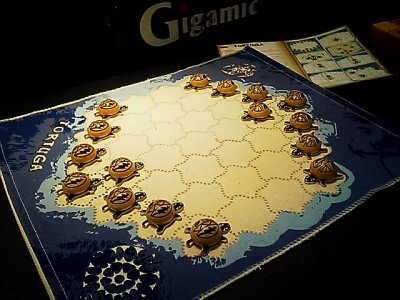
The rules of Tortuga can be explained in a nutshell. Both players start with their turtles positioned at their baseline, and in a player's turn one turtle may be moved for one step forwards. The movement always must be straight or sideways forwards, so that no backward movement is possible. However, a unique skill of the amazing Tortuga-turtles is the fearful turtle-jump, and so a turtle may jump over another turtle instead of moving. Even more, the trajectory may be extended if another jump is possible from the first landing space, and so a turtle may move forwards for several jumps in the same turn.
The only restriction to this happy jumping process is that a player may not jump over his own turtles and the other player's turtles in the same turn. This restriction is necessary because otherwise the turtles would be able to go too far, and since the first player to reach the other player's most remote baseline space wins, such an unrestricted jumping would ruin the game. Instead, the players need to position their turtles to get into a good position while at the same time hindering the forwards movement of the opponent's turtles, and in addition it is also necessary to prevent the opponent's turtles from jumping too many self-owned turtles. If a turtle is jumped over by an opponent turtle, it will be turned on its back and becomes neutral, and so a player's turtle force slowly may be diminished. However, the first player to jump a neutral turtle is allowed to put it on its feet again, but he now may chose whether the turtle joins his own force or is assigned to the other player (the rules say there are situations when this might be a better choice).
Most of the games designed and published by GIGAMIC impress with their wooden components and simple playing mechanisms, but Tortuga once again proves that GIGAMIC had a good hand when it comes to adding new abstract games to their portfolio. The game offers a nice challenge for player's with a knack for chesslike thinking, and although I tried my best I couldn't stop Nicole's turtles from winning the day.
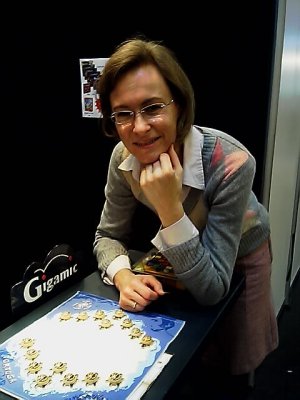
So, after this short excursion to the Isle of Turtles, Nicole and I once again tried our luck for a free table at the YSTARI booth, but before I tell you whether we were successful let's first have a look what Ralf was doing on this final day!
|
Hi folks, it's me again! Today it's the last day of the show, so let us start right away: Friedemann Friese (2F) came with two new games this year. The big Fürstenfeld and a small card game, named Famiglia. Due to the big rush for the first game I had a closer look on the latter. Famiglia is a pure two player mafia game. Each player controls a street gang and tries to attract the mightiest gangsters from four different families. The game is quite simple: With the gangster cards in their hands, the players try to recruit gangsters from the street, a display of up to six gangster cards in the middle of the table. All gangsters have a strength from 1 to 6. To get a gangster from the street, the player has to play two identically cards from the same family that have one rank below the gangster the player wants to take. One of these gangster is lost for the player, the other goes to his own display in front of him. A gangster with the rank 0 can be taken for free. So bit by bit the gangs become stronger and stronger and in the end the player with the mightiest gang wins the game. Sounds a little bit boring to you? Well, your were right, if there are not the special abilities of the different families. Each member of the same family has its own advantage in the game. So for example there are brutes, who can frighten the gangsters from the public display. This results in a loss of rank and as a result the player can get the gangster much cheaper. On the other hand there are the bookkeepers who enable the player to get gangsters back on the hand from his own display. You can find nothing really new in Famiglia. But the special features of the families and the familiar good and funny design from 2F makes the game worth trying out. From time to time, between two other games or for nightcap the game might be the right for the one or other. At any rate, I will have a heavier test and write a review about this in the next weeks. 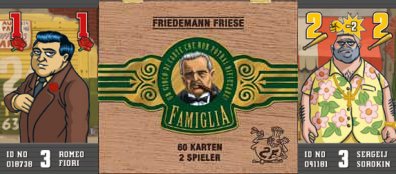 After that I hurried to the booth of KRISMU, because here you could watch again the famous "Abwracken" show at 12 o'clock. Although the "cash for clunkers" campaign in most of the countries has ended, KRIMSU still collects old games from the people and throws them to the waiting mass at lunchtime. Again a great show! KRIMSU began with a mighty voice and so he was able to attract attention of a lot of people. A specialty and a novelty of this year was, that in some of the games an additional voucher for a game of PEGASUS was hidden - a nice extra indeed! 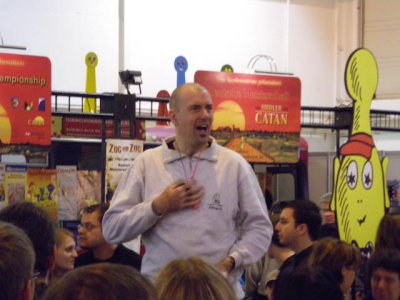 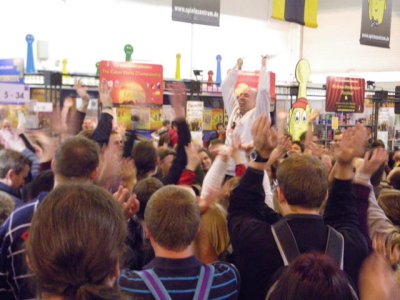 Later that day, I had the chance to have a closer look on the newest expansion in the Dominion world, it is already the 4th. Dominion - Prosperity is its name. All is about money and again the exansion adds 25 new Kingdom cards to Dominion. It can be played alone or be combined with all other Dominion games. A closer look and a first testing round confirmed my first impression. Almost every card of the game has some relationship to money and there is a lot of buying and additional buying and finally there are very expensive new cards in the game. Of course the basic rules of Dominion remain the same. A set of 10 different Kingdom cards are chosen, either out of the expansion or combined with some other (standalone) games. Prosperity introduces a new currency, platinum, that is worth 5 bronzes. And then you have a new colony pile, that is worth 10 victory points. Of course this card has its prize. You have to pay 11 coppers for it. Those of you, who are familiar with the other boxes of Dominion probably wonder how in hell one should be able to pay such a high amount of money. But for this the new Kingdom cards are a big help. Next to some mighty usual Kingdom cards, Prosperity introduces Treasure Cards with rules on them. They count as normal treasures but have special abilities, too. As an example, the bank is worth 1 copper per Treasure that is in play. So in a hand with five treasure cards, the bank is worth 5 coppers. So combining the treasure cards can bring you a lot of money for your purchases. The second innovation are player mats that are used with special tokens and they come in use with three of the Kingdom cards. At the end of the game these tokens count as victory points, a similar effect as we already have seen in the Dominion-Seaside expansion. Finally there is a Trade route on which Coin tokens are collected, if the Kingdom card Trade route is in play. These coin tokens are moved from a Victory card pile whenever a player gains such a card from the Kingdom. Trade routes give the player as may Coppers as there are coins on the Trade route. So, with progressing time the Trade route cards becomes more and more valuable, another method to buy the very expansive cards in a later phase of the game. I personally liked playing the newest expansion of Dominion. Prosperity expands the possibilities of the game. A new tactic is to concentrate on money much more longer than before and then just right before the end there is a big chance to catch up with people who were starting collecting victory points right at the beginning. But this is also a risk. If you are too late, there are not enough rounds left to start the pursuit race. Anyway, like in all other variants of the game, it is always a joy, to see your possible moves growing from round to round. As I have said before, for me Dominion in spite of the new Thunderstone and other variants remains the strongest game. But in the end this is a matter of taste. 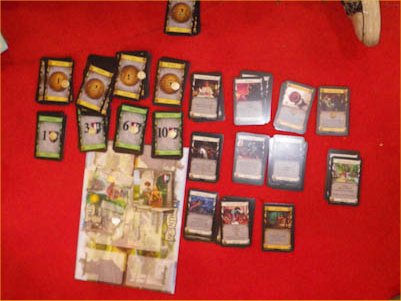 My day ended at the booth of TENKIGAMES where I had the chance to playtest Dakota. This is game about Indians and colonists and about resource management. The game starts with a choice of every player which faction he wants to play in the game. At least one native and one settler player must be found in every game. The choice influences the value of the different resources on the board. So for example buffaloes are very important for the Indian players, for the settler faction gold is much more important. The board is divided into five different type of landscapes. The landscapes again are divided into territories where the resources can be earned during the game. Each territory has two spaces used to place respectively native and settler pieces during the game. Additionally it as two rows for the resources. In the game the resources from the upper row must be collected, before the second is filled up. When the second row is emptied, too, then the next territory of the same type of landscape is filled up. So in the game there is always only one territory of each landscape type "in use". The main part of the game is the struggle for the resources. Starting from the first player, each player takes three of his explorers (either natives, or settler depending on the player's faction. These explorers are placed on a territory from which the player wants to collect resources. In the second placement phase, the players beginning with the last player who has set his explorers places and going counter-clockwise now place three neutral explorers. He may choose the faction freely, as long as there are enough neutral settlers left in the game. So he either can strengthen his own faction in some territories or the other faction in some other territories. The number of neutral settlers is balanced at the beginning of the game, so that the sum of player's and neutral settlers is equal for every faction. When placing the neutral settlers, a good tactic can be to place the other faction's neutral settlers to an area where they can do no harm to the player's settlers. Then for the fallowing players there are not enough neutral settlers left to harm the player. When the second round of placement is over, the strength of every faction is determined on the territories each. Only the stronger faction may collect resources, one for every settler of the victorious faction. What can one do with all the resources? They can be used to develop the player's tribe. So the player will get bonuses (for example another settler) and victory points. Despite of the huge board, Dakota is not very complex and can be played in about one hour. The well-balanced struggle for the resources is interesting and seems to attract younger and older people. The game is tactical, but not too much. To win the game you must try to build all bonuses that give victory points and additional to that a lot of money is needed. This a player can get by selling resources on the market. Later you can buy victory points with this money. I personally had excepted a little bit more from a game with a price of over 40 euros. Nevertheless, Dakota has left a positive impression. 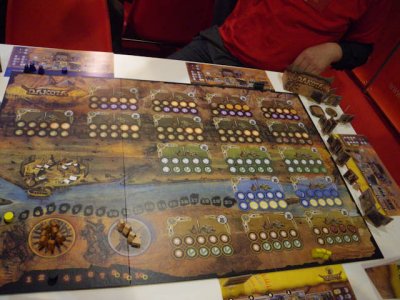 This ends my testings for today, but not for this year. We already have a lot of interesting review games that we will playtest in the next weeks. So stay tuned and always check back at the G@mebox for the newest reviews! Thanks for reading, and see you all again next year! |
Thanks Ralf for all your help - it's really appreciated!
Funny enough, Nicole and I had ended up playing a round of Thunderstone while Ralf has tested Dominion Prosperity. YSTARI still had no free table, and since Ralf's short testing session on friday has made us curious whether Thunderstone might be a good alternative to Dominion Nicole and I sat down on a free table at the PEGASUS-booth which was right next to ASMODEE.
Review: Thunderstone, Mike Elliott, PEGASUS SPIELE, 1 to 5 players
The sheer volume of games published each year makes it more and more difficult to keep an overview, and now and then it happens that I miss a good game which could be worth a playtesting. One of the games which I have skipped so far was Thunderstone from ALDERAC ENTERTAINMENT (AEG), and upon my first opening the Thunderstone-box at the presentation table the loads of cards and the absence of a gameboard and other kinds of tokens strongly reminded me of Donald Vaccarinio's Dominion. And indeed, it is not just the outer appearance of the game which offers some similiarities with last year's bestseller, but also the basic setup and gameplay mechanisms offer a strong semblance between both games. Thus, Thunderstone contains an assortment of different card decks belonging to three major categories (Hero, Monster and Village-cards), and at the beginning of the game the players will randomly determine four Hero decks, three Monster decks and eight Village decks which will be used for the game. In addition, basic decks for "Militia", "Torches", "Iron Rations" and "Daggers" are added, and they will be used in each game regardless of the other card decks which will be used.
From the basic decks each player receives his own starting deck of six Militia, two Daggers, two Iron Rations and two Torch cards, and each player shuffles his deck and draws six card to form his starting hand.
So far the Thunderstone-rules will sound quite familiar for all Dominion-fans, but from this point onwards both games will move on somewhat separate alleys. In Thunderstone the active player has three different options how he might spend his turn. So, the player may
The monsters in the dungeon are the ultimate combat test for each player's deck of cards, since three Monster-card always are revealed on the table, waiting for the players to attack them with the cards in their decks. The three different monster decks which were chosen during setup all are shuffled into one big Monster-deck in which the player's goal, the Thunderstone-card, will be hidden. The Thunderstone-card is placed in the lower third of the Monster-deck, and when enough monsters were slain by the players the Thunderstone will appear. The claiming of the fabled Thunderstone by one of the players marks the end of the game, and now all players will add up the value of their card decks and slain monsters, and the player with most victory points will have won the game.
But how does the monster-slaying-business work? At the beginning of each turn a player receives a fresh hand of six cards from his own deck, and since no cards from the last turn may be kept, the player may only use these six cards to decide on his strategy for the current turn. If the player decides to go into the dungeon, he must chose one of the monsters which he wants to attack. He then checks for the Monster's strength rating, and modifies this rating by the position of the monster within the dungeon. There is one monster in the first second and third rank, and when a monster is slain all other monsters move forwards and the last slot then is re-filled from the Monster-deck. The position of a monster in the dungeon determines how dark the surroundings are (3rd rank is darkest), and with increasing darkness the monsters get an increasing modifier on their strength rating. In addition, the monster also might have a special ability which either may influence its strength or cause some other kind of trouble.
Once the monster's strength is calculated, the player starts to play cards from his hand. These cards may be heroes, spells, weapons etc, and the player will try to play cards with a total strength rating exceeding the monster's strength. However, some basic restrictions need to be observed here, and so a player only may play one weapon card for each hero he uses in this combat, and furthermore the weapon associated to a character may not be heavier than the hero's maximum weight limit.
If the attacking player succeeds in slaying the monster, he will receive the monster card to add it to his discard pile. The card may have a Gold value which may be used during a visit at the village, but some monster trophies also may be useful in a later combat. In addition, the monster card has a victory points value which will be counted when the player adds up his total score at the end of the game, and as a further bonus the player also receives some Experience cards. These cards do not become part of the players deck, but instead he keeps a separate stockpile of experience cards.
If the attacking player looses to a stronger monster, the monster will be disgruntled and moves back to the bottom of the Monster-deck, making room for the other monsters to move forward and for a new monster to be added at the third dungeon rank. However, some monsters also cause damage, and this may force the player to draw a Disease-card which must be added to the player's deck. If - in a later turn - the player has one of these disease-cards on his hand while visiting the dungeon, the disease card MUST be played, leading to a reduction of the player's total strength for this dungeon visit. However, there also exist some options to discard Disease cards, and these options encompass either the spending of a full turn for a resting action or the use of Clerical powers.
As might be guessed, the battles in Thunderstonedraw most of their tension out of the question how well the cards in a player's hand fit with each other. Most of the cards possess some special attributes, and it will be up to the player to construct a deck during the course of the game which contains a good choice of corresponding cards. However, it is not only the choice of cards which must be considered, but also the balancing of the player's deck is an essential part of the game. Due to the fact that a fresh hand of six cards must be drawn at the beginning of each turn there is no possibility to save a good card for later, and so a player must construct his deck in a way to increase his chances to get a hand of cards supplementing each other.
New cards are acquired in the village, and when a player decides to use his turn to make a visit to the village he is allowed to buy one card from either one of the eight Village-decks, a Hero-deck or one of the four basic decks. To make this purchase, the player uses cards from his hand, since many cards have a gold value which will give the player the possibility to make additional purchases. However, it is essential here to note that cards used to make a purchase are only discarded into a player's own discard pile (so that they remain part of the player's deck).
As indicated, the choice of cards available at the village depends on the game's setup, but overall Thunderstone offers a broad variety of cards with different special abilities. There are cards which increase the attacking value, cards for making ranged attacks, cards for healing, cards for making additional purchases etc, and by fitting purchases from the choice of available cards the player slowly will increase the effectiveness of his deck both in the dungeon and in the village.
An important special option available in the village is the possibility to "Level up" a hero. Each Hero-card exists in three different levels, and at the beginning the players only may purchase the level 1 heroes which can be found on top of each deck. However, if a player has accumulated some experience, he may check his hand of cards when visiting the village whether he has enough experience to level up one of the heroes from his hand. He may then discard the required amount of experience, remove his old hero from the game, and instead take a take the same hero card with a higher level from the corresponding Hero-deck. In this fashion the heroes can be brought up to level 3, stepwise increasing their powers.
As indicated, the players need to adjust their purchase policies in order to keep their deck of cards balanced. A streamlined, compact deck with effective cards is especially nice to have during the first half of the game since such a deck allows some well-targeted strikes against the evil monsters. However, the players need to keep their deck evolving as monster-trophies come in, since too many trophies and too few other cards will clog the deck up and make it ineffective. Also, players with a liking for role-play-games will feel a strong urge to create a "nice" deck with different heroes and weapons matching their fancy of a nice adventure party, but the key to winning Thunderstone is effectiveness! No price is given for the best looking party, but instead the challenge is to find the best combination of matching cards for cutting surgically through the monster ranks. Here the random setup of the game works marvellous, since every game brings its own combination of cards and with it its own unique challenge.
Wow, I am glad that Ralf's testing session has pointed us to check this game out. To be honest, I think that Thunderstone perfectly matches the expectations I first associated with Dominion, and here especially the perfect combination of playing mechanisms and background story can be mentioned. Whereas Dominion always has has left me with the impression to be a rather "mechanical" deck-construction exercise, the whole process of deck-construction is integrated much more smoothly in the Thunderstone-rules. Thus, despite the focus on an effective monster-slaying-business, the players get a feeling that their characters are evolving and that they follow a clearly specified goal. Even the Disease-cards seem to be more fitting from an atmospherical standpoint, since they nicely carry the image of the player's band of heroes getting exhausted by the constant dungeoneering.
On a more down-to-earth approach, the similiarities between both games cannot be denied. Both games operate on a mechanism of deck-building, and on the rules level they are separated only by a few minor but decisive twists. However, it is exactly these twists, which make Thunderstone superior to Dominion, since the general orientation of Thunderstone is more variable. Thus, the Dominion players each turn circle through their decks with the same aim - getting more purchase actions plus money and (possibly) finding some fitting interactive cards. Thunderstone leaves the players with a decision either to visit the village for shopping/levelling-up OR to visit the dungeon in order to advance towards the general goal of the game, and the variety of monsters in the dungeon actually gives the players a somewhat more sophisticated, evolving challenge.
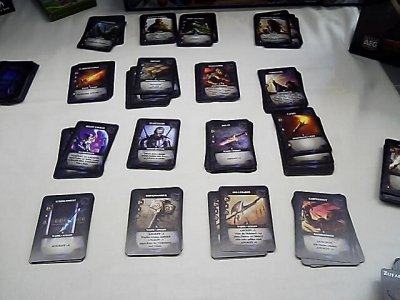
After the session of Thunderstone Nicole and I had lost hope that we might get a chance to play Mousquetaires du Roy, but nonetheless we rounded the ASMODEE booth for a final time just to make sure. And indeed, we were lucky because a group of players just was leaving a table, and so we quickly sat down, grabbed a game instructor and started our swashbuckling adventure!
Whereas the name of both the French and English version of the new YSTARI game remains the same, the German version has been named Mylady und die Musketiere, and name which will probably appeal more to the German buyers than the use of the original French name. While it is true that Germany and France are neighbouring countries in central Europe, it is still surprising that the French language is treated rather stepmotherly in German schools. English is predominant, and it's popularity is followed by ancient Latin, and so it is no wonder that ASMODEE has made the move to give the game a German title. But let this be enough about schools - let's go for some action…
Review: Mousquetaires du Roy , Francois Combe & Gilles Lehmann, YSTARI, 1 to 5 (6) players
The new game is focused on the story The three Musketeers by Alexandre Dumas, and up to four players can cooperate to take up the roles of the musketeers who embark on a mission to return some diamond jewellery to the Queen of France. The Queen had given this piece of jewellery to her English suitor as a token of her love, and now the sinister Cardinal Richelieu is trading to compromise the Queen by inviting the Queen to a Royal reception where she is supposed to wear that jewellery. So, the musketeers have been sent to recover the jewellery from England, but to make the whole mission a real challenge a fifth player is joining the game on side of the Cardinal - his alluring and dangerous agent Mylady de Winter.
Okay, we have seen some rather successful cooperative games in the last years, sometimes with all players teaming up on the same side like Knizia's classic Lord of the Rings or the beautiful Shadows over Camelot. On the other hand, there were some games where of the players had to stop the others from reaching their goal, and here an example is the Sauron expansion for Lord of the Rings or a plethora of older RPG games like Heroquest where only player has to take the role of the gamemaster. However, many of these games actually failed to provide the role of the mugwump with real tension. Actually, those players needed to enjoy the position of a "game manager" instead of real participation, and only a few games actually succeeded to involve the maverick on a real gaming level.
The position of Mylady de Winter in Mousquetaires du Roy actually seems to be one of the rare examples where the fusion between cooperative gaming on the one hand and a sinister loner on the other hand does work, providing the Mylady player with enough powers and playing to move him from the manager's seat to a real participant. During the game, Mylady will secretly move around the different locations on the gameboard, being revealed either after the musketeers have moved or when being discovered by a musketeer visiting the same place. For this mechanism to work, Mylady has to envision which moves the musketeer players possibly will make, and she has to play a secret card which will name her whereabouts for the current turn.
Locations on the gameboard are Mylady's House, the Musketeers quarters, Richelieu's office, the Bastille (prison), Paris, the Louvre and the beleaguered city of La Rochelle. Furthermore, one space is reserved for the current stage of the musketeer's quest to recover the Queen's lost jewellery, and if the musketeers should succeed in solving all four stages of this quest the musketeer players will have won the game. However, time is running against the musketeers, and so Mylady will mark the beginning of each new turn on a corresponding track, and if 12 turns have passed without the musketeers successfully solving the last stage of the jewellery quest their delay has become to great and Mylady will have won the game.
The musketeers players are equipped with a nice character sheet showing their character and his statistical values, going from classic life points over to ratings for the following four attributes: Education, Nobility, Gallantry and Verve. In addition, each character has a rating how many dice he will roll in combat, a special dice combination showing the character's secret blow, and a special ability which will be unique to the character. Many of the quest cards which are revealed during the game require the musketeers either to pass a challenge for one of their attributes or a combat, and here the Adventure cards which the players can earn during the course of the game come in quite handy. Using these cards they can get a temporary increase of a specific attribute in order to pass an attribute test (note: no dice are rolled here!), or they can increase the number of dice they roll in combat up to a maximum of six.
Combat is dealt with in a streamlined but efficient way. The player rolls a set of combat dice for his musketeer, whereas Mylady rolls a dice for the adversary which she has placed against the musketeer. The players need to roll "Sword" symbols in order to inflict a wound on their enemy, but each rolled "Shield" will cancel out a "Sword" rolled by the opposing player. Under normal circumstances the combat ends after one player has inflicted at least one wound (most of Mylady's henchmen only have one Lifepoint), and if the musketeer player has been successful the challenge will be considered to be solved.
Challenges can be found everywhere on the board, and it will be the task of the Mylady player to use her henchmen and traps to the best possible extend and to acquire additional treachery cards which will make the life of the musketeers even harder. Thus, The Mylady player will use his action to do some mischief on the gameboard, and if he should have matching cards he is also allowed to make some new missions even harder for the musketeers by adding a trap of some henchmen from her hand. The musketeers on the other hand will have to use their three actions per player wisely to prevent any catastrophe which will lead to a victory of Mylady. Thus, they will not only face the task of returning the jewellery to the Queen within the set timeframe, but they will also need to prevent other disastrous events from happening. Thus, they need to keep an eye on the Louvre since the missions there - if not solved in time - will lead to a stepwise dishonouring of the Queen. At the same time they will need to keep an eye on Paris, where D'Artagnan's lover Constance is under a constant threat that Mylady might kill her. As if this should not be enough, the battle at the city of Le Havre is threatening to end with a victory if the rebellious Huguenots, and so the musketeers need to keep the balance of power token at this city to sink too deep for the Cardinal's favour (a bit similar to the Grail-quest in Shadows over Camelot).
Mylady is in the middle of this, moving secretly from place to place to spread her dangerous intrigues. If a musketeer visits the same location, Mylady is revealed, but in most circumstances this discovery only will cause additional trouble for the musketeer trying to solve a task. Thus, a meeting at Paris or the Louvre will force the musketeer to fight the formidable Rochefort, Mylady's bodyguard. Despite Mylady's Lara Croft-like look on the gameboard Mylady does not go into combat herself, and so she sends Rochefort in, and in difference to some of Mylady's other henchmen Rochefort is a skilled swordsman (more combat dice) and he possesses five lifepoints, making him a dangerous foe to deal with. Only at Richelieu's office will the musketeers appearance prevent greater mischief, since the musketeer's presence will prevent Mylady from drawing additional treachery cards which she otherwise would have been entitled to. However, if the musketeer's speculation on Mylady's current location was wrong, Richelieu will send the musketeer to the Bastille where he has to spend the rest of his turn.
As indicated, the musketeer players need to fight their way through all four stages of the quest for the jewellery to win the game, but apart from the numerous challenges the players will have to solve Mylady also a possibility to appear at the current quest location to position Rochefort to delay the musketeers even further. To make a bit up for this sinister character, the musketeers have the possibility to use an action to visit the Arsenal. Money can be earned especially by preventing some grave danger at the Louvre, and so the musketeers can use this money to by equipment like a musket, a stallion or a healing salve which all will have some helpful effect. In addition, a musketeer also may opt to train at the arsenal, thus increasing one of his attribute ratings by one.
When I saw the first images of Mousquetaires du Roy while preparing for the SPIEL I was getting rather impatiently to give this new game a try. I like the comic-like artwork in the game (which is clearly a tribute to France's great tradition of comic drawing). And indeed, the game did not disappoint Nicole and me! As indicated above, authors François Combe and Gilles Lehman did a great job transforming Dumas' novel into a challenging boardgame, and my praise falls even higher due to the manifold options available to Mylady to interact with the other players. The Mylady player faces a difficult task of timing, moving on the board and trying to speculate the next moves of the musketeers. The musketeer players are allowed to talk to each other and make up their plans, but to symbolize Mylady's spy network all talk must be made openly, and any cards revealed must be shown to Mylady as well. Thus, in clear contrast to many older games, the position of Mylady in Mousquetaires du Roy indeed moves the fifth player from the position of the mystical gamemaster to a real player, and so a great degree of tension and even some nice-roleplaying elements can be found in this game.
As a sidenote, I should also mention that people buying the game here at the show received a fifth musketeer miniature and playing sheet as a special convention goodie, increasing the number of possible players to a total of six. However, those of you unable to attend should be at ease - I have read a comment of one of the game designer's somewhere in the net, telling that the RIO GRANDE version of the game actually will include the character sheet of the fifth musketeer as well.
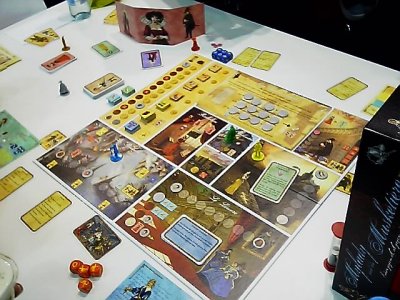
Well, in the end Nicole and I had been able to play Mousquetaires du Roy, and this brought not only our day at the SPIEL '10 to a good ending, but also my reporting from the SPIEL '10 now is on drawing to its close. After saying goodbye to many of our friends at their booths, we ended the day at the show with a visit to both BOARDGAMEGEEK and FAIRPLAY in order to check out the final winners of their visitor popularity votings. I was quite happy to see that 7 Wonders from REPOS PRODUCTION won at FAIRPLAY and came second on BOARDGAMEGEEK, so this game definitely has found some high esteem with many of its players. The BGG vote actually was won by Survive!, but as it seems this game like many other high-ranking games has fallen short of my own list of testing priorities. Well, with games abound to test, there is always a huge lot of games which I cannot get around to play, but with the high ranking games often receiving enough public attendance I usually tend to present you some more obscure titles which otherwise would be overseen in the sheer masses of new releases.
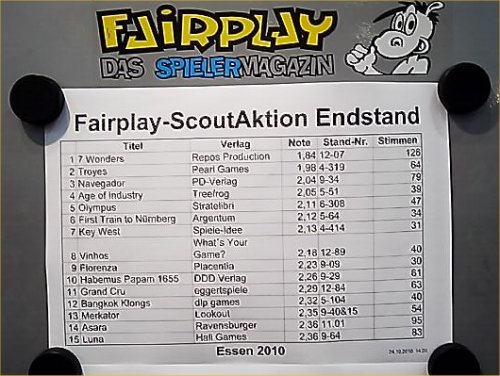
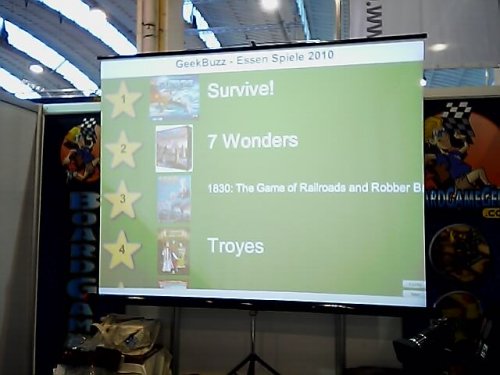
Before I come to my annual recommendation of the game I liked most at the fair, let me also give you the final card for Jerusalem - The Kingdom of Heaven.
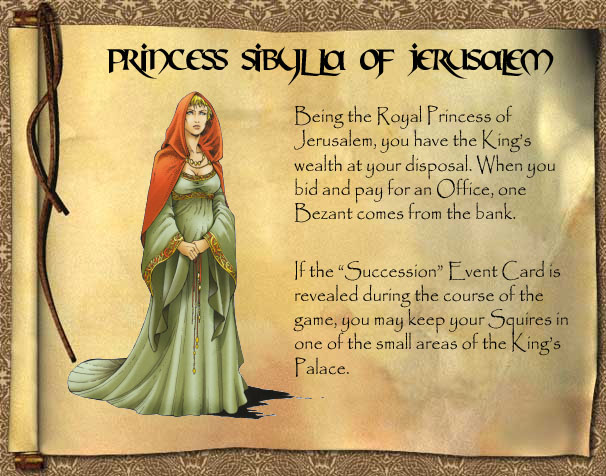
Please note that the character-artwork for this character comes from the thrilling French comic series CROISADE (=crusade) by Jean Dufaux and Philippe Xavier. All rights to these graphics are reserved to the authors. No challenges to their status are intended.
As a general rule for all four character sheets, you should note that a player receives a bonus of one Prestige point by the end of the fifth round if the player could not use the character's event-based ability.
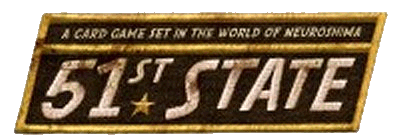
Quite interestingly, one of the games I had played right the beginning of the SPIEL '10 convention also turned out to be my favourite game of the whole show. So, I would like to give my special recommendation to the game 51st State by Ignacy Trzewiczek because I think that the game is a perfect example of a fusion between and interesting build-and-develop playing mechanism and a fitting background story. Mind you, this recommendation certainly is based on a subjective assessment, and as I told you I have a liking for a post-apocalyptic setting due to my early days as a computer gamer. However, this recommendation is not made on pure sentimental feelings, but because I had the impression that the game runs rather smoothly and puts the player's into a tough competition to be the first to reach the required 30 victory points. So, the player's keep their focus and forwards drive in a similar fashion as in Race for the Galaxy, and so I think my recommendation definitely is justified.
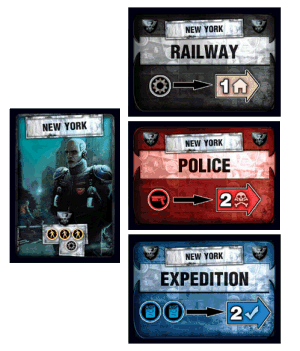
As a side note and general observation, I would also like to point out that I am absolutely astonished to see that so many high quality games come from Poland this year. I was hard pushed to decide on my final recommendation between 51st State, Magnum Sal and K2, and all three of these games certainly deserve a much better standing than their final positions at both the FAIRPLAY and BOARDGAMEGEEK rankings might suggest. So, POLAND rules this year at the SPIEL!

As for the prize draw, there is still a chance for you to win a copy of Antics! or some of the mini-expansions and goodies distributed by the publishers here at the SPIEL '10! I will keep the prize-draw open for the next couple of days, so don't forget to sign my SPIEL Guestbook to get a chance to win!

Talking about my guestbook, I once again thank all of you for taking the time to comment on my work. It's delighting for me to see that so many people around the globe are following my virtual footsteps, and this actually keeps me going at such a high pace for the whole week.
So, the time has come to say goodbye from the SPIEL '10. I hope you will be able to find some good games to play after reading all my tests and reviews, and I certainly hope to see you all back here for the SPIEL '11!!!
For now, Nicole and I (and our friend Harvey!) wish you all the best and - of course - a lucky dice hand in your upcoming gaming sessions!
All the best!
Frank Schulte Kulkmann
from Essen, Germany

You can also go by train to Essen Central Station. If arriving there, go to the basement and take the Subway U11 directly to the Messe Essen.
If you want to arrange lodging at Essen, you best contact the Essen-tourism-center by phone 0049/(0)201/19433 or 0049/(0)201/88720-46 or -48. Perhaps they know where some Hotel-rooms are left...
If you travel to Essen by car, please notice that Germany restricts access to many cities (including Essen) for older cars. While the convention area does not fall under these environmental restrictions if you follow a specific route, you might want to check out the route details at the official Messe Essen website. An even better alternative (especially for those of you having a hotel in Essen) would be the acquiring of an Envirnomental Badge which can be ordered at the offical website of the German Technical Inspection Authority.
If you want to have a look at my coverage of previous conventions, follow these links. But you should bring along some time, especially of you want to read the younger reports...
|
| |

Looking for the new games? Visit Funagain Games! |
|
|
| |
|
Kulkmann@aol.com
Copyright © 2010 Frank Schulte-Kulkmann, Essen, Germany | |